Disclaimer
Charles Willson Peale
American Painter, Engraver and Scientist
1741 - 1827
Self Portrait: 1822

Son of a convicted felon whose early death left the family impoverished, Charles Willson Peale went on to lead a staggeringly full and successful life. A portrait painter who produced an unparalleled body of work, including the iconic 'The Artist in His Museum', Peale was also a revolutionary soldier, a radical activist, a natural historian, an inventor, and the proprietor of one of the first modern museums. His many other interests included a lifelong preoccupation with writing; in fact, his autobiography is one of the first examples of the genre in the United States. David C. Ward's engaging book, richly textured with references to the history and culture of the time, is the first full critical biography of Peale. It links the artist's autobiography to his painting, illuminating the man, his art, and his times. Peale emerges for the first time as that particularly American phenomenon: the self-made man.
The Artist in His Museum: 1822
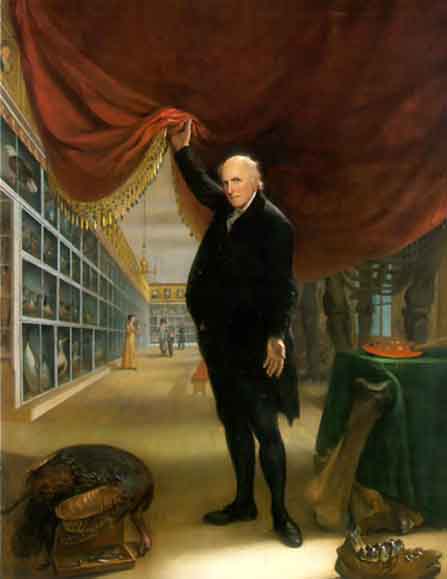
The Artist in His Museum is an 1822 self-portrait by the American artist Charles Willson Peale. Toward the end of his career, beginning in 1822, he painted seven self-portraits that together formed the final motif of his art and the final flourishing of his talent. The Artist in His Museum is a large-scale oil-on-canvas work painted in about two months, and is the most emblematic of Peale's many self-portraits.
Peale was born in Chester, Queen Anne's County, Maryland, the son of Charles Peale and his wife Margaret. In 1749 his brother James Peale (1749-1831) was born. Charles became an apprentice to a saddle maker when he was thirteen years old. Upon reaching maturity, he opened his own saddle shop; however, when his Loyalist creditors discovered he had joined the Sons of Liberty, they conspired to bankrupt his business.
Finding that he had a talent for painting, especially portraiture, Peale studied for a time under John Hesselius and John Singleton Copley. John Beale Bordley and friends eventually raised enough money for him to travel to England to take instruction from Benjamin West. Peale studied with West for two years beginning in 1767, afterward returning to America and settling in Annapolis, Maryland. There, he taught painting to his younger brother, James Peale, who in time also became a noted artist.
John Beale Bordley: 1770
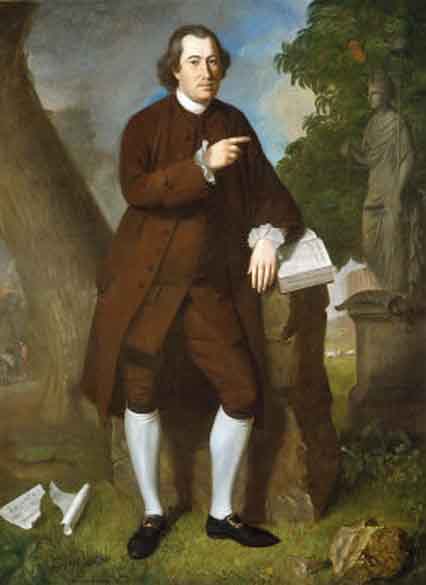
John Beale Bordley, a close friend of Charles Willson Peale, raised the funds in 1766 to send the young artist to London, where Peale trained under Benjamin West's tutelage. In the stormy years before the American Revolution, Bordley was a Maryland planter, judge, and member of the Governor's Council. A fervent republican, he gave Peale his first major commission -- for life-size, symbolic portraits that were to be exhibited in London as declarations of colonial opposition.
The portrait addresses two political issues: America's agricultural self-sufficiency, and her fair treatment. The first of these concepts is referred to in the background, which depicts Bordley's plantation on Wye Island in the Chesapeake Bay. A peach tree and a packhorse signify America's abundance, while the grazing sheep speak for freedom from imported, British woolens. The theme of tyranny dominates the foreground. Bordley, trained as a lawyer, assumes an attitude of debate, raising his hand in a gesture of argumentation. He points to a statue of British Liberty holding the scales of justice, reminding English viewers that the colonists lived under British law and, thus, were entitled to the rights it guaranteed. That Britain had violated these rights is signified by the legal document, torn and discarded at Bordley's feet. A poisonous plant at the statue's base -- the native American jimson weed -- warns of the deadly consequences of any attack on American civil liberties.
Matthias and Thomas Bordley: 1767
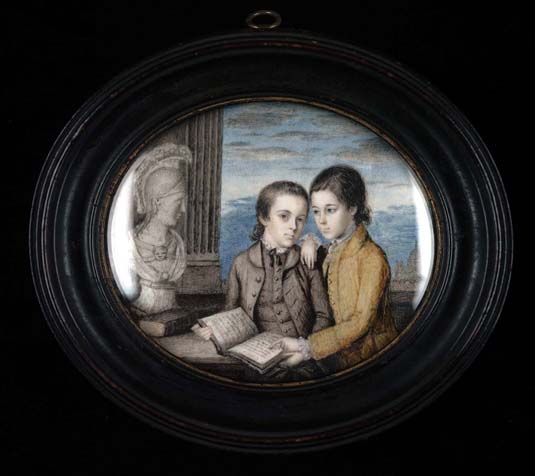
Charles Willson Peale's tender portrait of Matthias and Thomas Bordley presents the young sons of John Beale Bordley, Peale's early patron. This oval miniature is a reminder that such keepsakes were often painted to comfort the owner in the absence of the people portrayed. Bordley's sons had just arrived in London to be educated at Eton, under the watchful eye of a family friend. Here, Peale shows them with a bust of Minerva, Roman goddess of wisdom, with a view of St. Paul's Cathedral in the background. Bordley had paid to send Peale to study in England, and during this trip the artist painted this miniature to give to the boys' parents in Maryland. An inscription on the back indicates that Matthias was nine and his brother Thomas twelve years old when this was painted. Although Matthias would live to adulthood, Thomas died in England of tuberculosis in 1771.
Henrietta Maria Bordley: 1773 (Age 10)
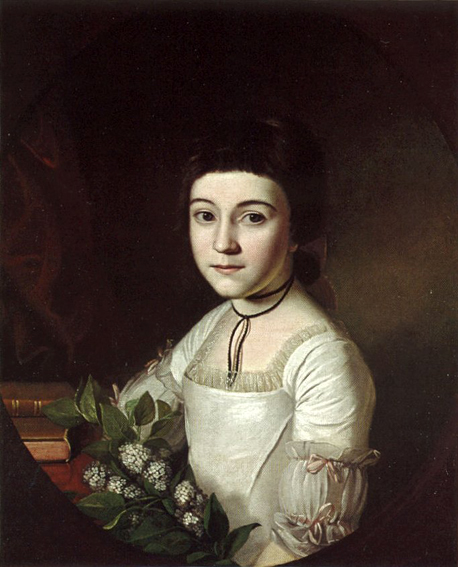
A Front View of the Statehouse at Annapolis: 1800

Peale's enthusiasm for the nascent national government brought him to the capital, Philadelphia, in 1776, where he painted portraits of American notables and visitors from overseas. His estate, which is on the campus of La Salle University in Philadelphia, can still be visited. He also raised troops for the War of Independence and eventually gained the rank of captain in the Pennsylvania militia by 1777, having participated in several battles. While in the field he continued to paint doing miniature portraits of various officers in the Continental Army. He produced enlarged versions of these in later years. He served in the Pennsylvania state assembly in 1779-1780, after which he returned to painting full-time.
Peale was quite prolific as an artist. While he did portraits of scores of historic figures (such as John Hancock, Thomas Jefferson and Alexander Hamilton), he is probably best known for his portraits of George Washington. The first time Washington ever sat for a portrait was with Peale in 1772, and there would be six other sittings; using these seven as models, Peale produced altogether close to 60 portraits of Washington. In January 2005, a full length portrait of 'Washington at Princeton' from 1779 sold for $21.3 million dollars, setting a record for the highest price paid for an American portrait.
Alexander Hamilton: 1791

Hamilton was at the height of his career when Charles Willson Peale painted his portrait for the Philadelphia Museum. The portrait appears to be a hastily done sketch re-worked sometime after the initial sitting. Only the face is painted in detail, and the hair and body don't exhibit the same degree of completion as Peale's other works from the same period. The ruddy palate used for the flesh tones is typical of the artist's work produced in the early 1790's.
John Hancock
(President of the Second Continental Congress: 1775-1777)

Thomas Jefferson: 1791
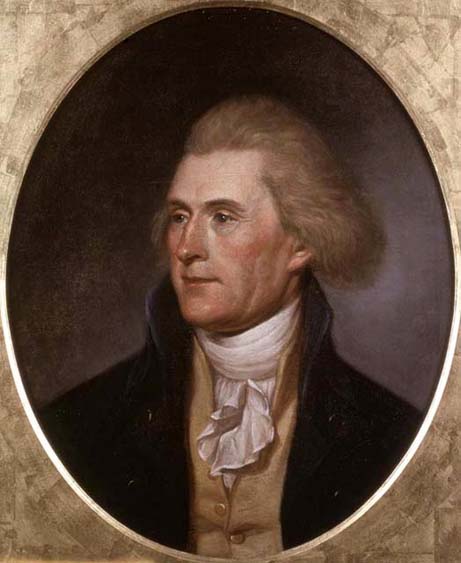
In 1791 Charles Willson Peale added this portrait of Secretary of State Thomas Jefferson to his museum's collection of American heroes. Jefferson appears younger than his fifty years, perhaps evoking the young man the artist remembered as the Virginia delegate to the Continental Congress. Jefferson was well known to Americans in 1791, having also served as governor of Virginia and ambassador to France.
Notwithstanding George Washington's desire for unity in his administration, Jefferson quickly found himself at odds with Secretary of the Treasury Alexander Hamilton, whose power and influence on the president rivaled his own. Jefferson favored a smaller, weaker national government, with more power residing in the states and closer ties to France; Hamilton argued for a powerful national government allied to Great Britain. From these differences the first American party system-Democratic-Republicans (Jefferson) versus Federalists (Hamilton)-was born.
Thomas Jefferson
(State Room Portrait: 1790's)
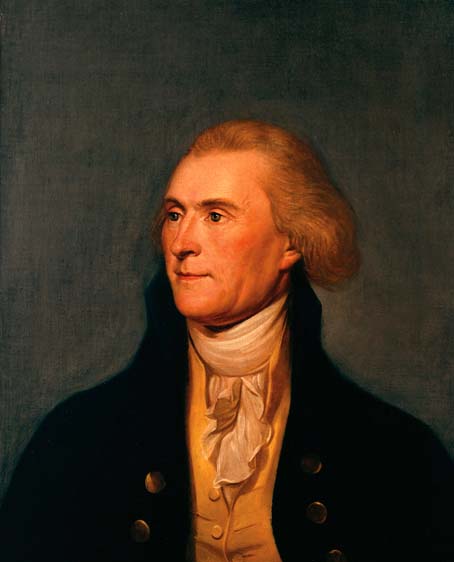
George Washington by Charles Willson Peale
George Washington: 1772
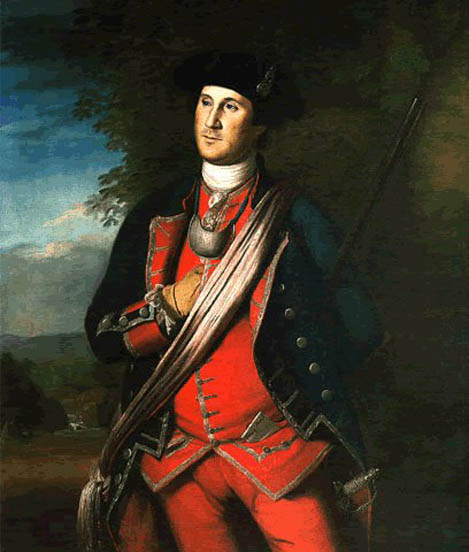
The earliest authenticated portrait of George Washington shows him wearing his colonel's uniform of the Virginia Regiment from the French and Indian War. The portrait was painted about twelve years after Washington's service in that war, and several years before he would reenter military service in the American Revolution.
George Washington: 1776
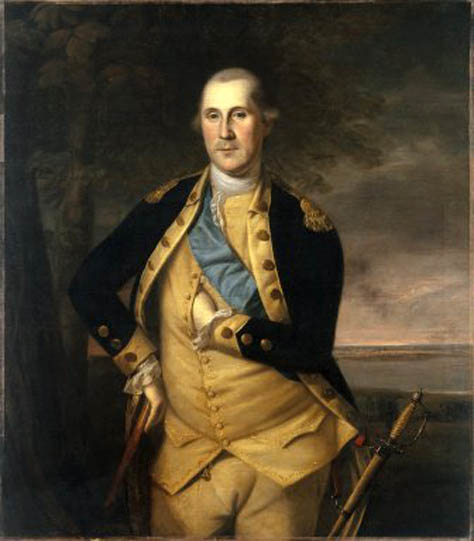
John Hancock, president of the Continental Congress, commissioned this portrait of George Washington as Commander in Chief of the Continental Army in order to flatter and reward him for liberating Boston (visible in the background) from the British in March 1776. Hancock wrote to Washington, "I beg, Sir, you will be pleased to accept my heartfelt thanks for the attention you have showed to my property in that town." Washington reluctantly accepted Hancock's invitation to sit for the Philadelphia painter and radical patriot Charles Willson Peale. In a diary entry dated June 1, 1776, Peale recorded work on the portrait along with these terse but resonant words: "This day the Continental Congress declared the United States Colonies Free and Independent States."
There are various interpretations of this painting which I have discovered in my various searches. They possess a commonality but then a uniqueness of their own. Yet, there is a form of 18th Century political propaganda very different from what see today. It says to me FREEDOM and LIBERTY.
George Washington at Princeton: 1779

Because Peale served under General Washington and befriended him during the Revolutionary War, he was an ideal candidate to compose this painting that commemorates one of Washington's most important early victories. Even the horse at the right appears impressed with Washington, upon whom he gazes with pride. Peale's painting was instantly popular, and the artist produced several versions of it amid a rally of enthusiasm for the American cause. Whereas some were commissioned by American colonists, others were ordered by Washington's admirers in France, Spain, Holland, Cuba, and even England.
One of the most remarkable figures in early American history, Peale was interested in natural history and organized the first scientific expedition in the United States. Later, Peale opened one of the first financially successful museums in America, displaying stuffed animal specimens, fossils, shells, and a large selection of his portrait paintings.
George Washington: ca 1780-82
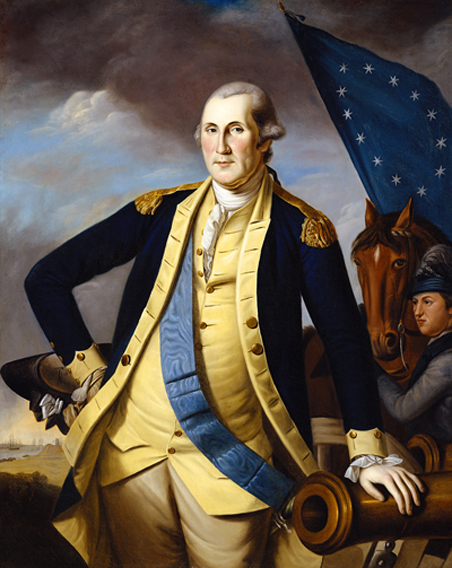
George Washington at the Battle of Princeton: 1784
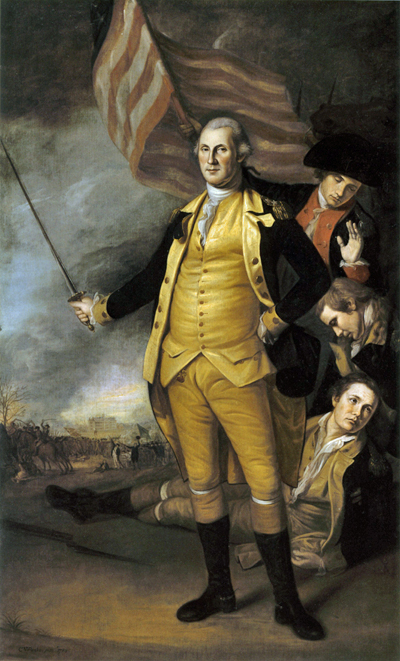
Charles Willson Peale painted George Washington more times from life than any other artist. In 1772 Peale visited Washington's home, Mount Vernon, to portray the hero as a colonel of the Virginia regiment, the only pre-Revolutionary likeness of him. In 1795 Peale and other members of his family painted the president for the last time during his second term. All told, Peale had seven opportunities to paint the great man at different times in his career, and he replicated many of the paintings.
None was as popular as the enduring image of Washington after the Battle of Princeton, which was commissioned by the Supreme Executive Council of Pennsylvania for its council chamber in Independence Hall in Philadelphia. The original, now owned by the Pennsylvania Academy of the Fine Arts, was completed in early 1779, when Washington sat for Peale in Philadelphia. An immediate success, it precipitated a great demand for replicas. Of the estimated 18 replicas, the superlative Senate picture is the earliest recorded one that Peale made, although there was a contemporary published notice that five replicas had been ordered as early as February 1779. The Senate picture was purchased from the artist by the French Ambassador Conrad-Alexandre Gerard, probably on behalf of Louis XVI, and paid for with a bill of exchange on July 15, 1779. The ambassador, who sat for Peale for his own portrait in September, took the painting of Washington home to France shortly thereafter and presented it to the king. This scenario is confirmed in a letter from Peale, dated October 15, 1779, to Edmund Jenings in Brussels. Peale sent Jenings a miniature portrait of Washington, with the remark that "The Likeness is something different from that which his Excellency Sieur Gerard Carries for the King."
One of his most celebrated paintings is 'The Staircase Group' (1795), a double portrait of his sons Raphael and Titian painted in the trompe l'oeil style. It is in the collection of the Philadelphia Museum of Art.
The Staircase Group
(aka Raphael and Titian Ramsey Peale): 1795
_1795.jpg)
By the time that Charles Willson Peale painted the 'Staircase Group', he had abandoned commercial portraiture to devote himself to natural science and to his museum and zoo at Philosophical Hall. To help foster the arts in Philadelphia, however, he was instrumental in founding the Columbianum, an artists' association modeled on the Royal Academy in London. For its first and only exhibition, Peale executed this painting to demonstrate that he remained one of the city's preeminent artists. On an unusually large canvas, he made one of his rare full-length portraits, showing two of his sons on an enclosed spiral staircase. Its high degree of detail and finish shows that the painting was clearly intended to be a trompe l'oeil "deception," an effect that Peale never attempted elsewhere. To enhance the illusion, he installed the painting within a doorframe in his studio, with a real step in front. Rembrandt Peale, another son, recalled that his father's friend George Washington, misled by Peale's artifice, tipped his hat and greeted the two young men as he walked by.
Peale had a great interest in natural history, and organized the first U.S. scientific expedition in 1801. These two major interests combined in his founding of what became the Philadelphia Museum, and was later renamed the Peale Museum.
This museum is considered the first. It housed a diverse collection of botanical, biological, and archaeological specimens. Most notably, the museum contained a large variety of birds which Peale himself acquired, and it was the first to display North American Mastodon bones (which in Peale's time were referred to as mammoth bones; these common names were amended by Georges Cuvier in 1800, and his proposed usage is that employed today).
The display of the "mammoth" bones entered Peale into a long standing debate between Thomas Jefferson and Comte de Buffon. Buffon argued that Europe was superior to the Americas biologically, which was illustrated through the size of animals found there. Jefferson referenced the existence of these "mammoths" (which he believed still roamed northern regions of the continent) as evidence for a greater bio-diversity in America. Peale's display of these bones drew attention from Europe, as did his method of re-assembling large skeletal specimens in three dimensions.
The North American Mastodon
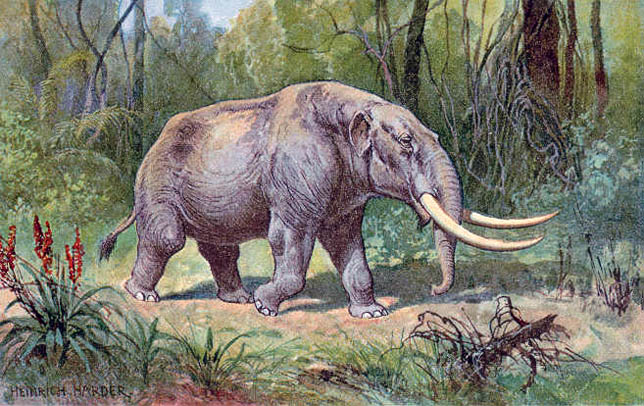
Exhumation of the Mastadon: 1805-08

Down in the pit, workmen are digging marl and hoisting it to ground level to be sifted for fossils. To deal with the continuous seepage into the pit, Peale constructed a special pumping system. It is a continuous conveyor belt of water buckets powered by a large turnspit, operated by three men walking forward inside it . The water is conveyed off-site by a trough.
Peale peopled his scene with more than fifty anonymous workmen, plus nearly twenty of his family members and friends. In the foreground, ascending the ladder from the pit, is Mr. Masten, the owner of the farm where the dig was located. At ground level, under the left leg of the structure supporting the conveyor belt, stand Elizabeth DePeyster Peale, the artist's second wife (deceased at the time he painted the picture), and their son, Titian. Almost hidden behind the right leg of the structure are two of the artist's other sons, Linnaeus and Franklin. At the boys' left stands James Peale. At left in the background, wearing a blue coat and standing beside Peale's tent-like tool room, is his good friend, the poet and ornithologist Alexander Wilson (1766-1813). In the distant background is the army officer's tent where Peale slept. At right the artist, who has been displaying his painting of a full-scale mastodon leg, acknowledges one of the workmen in the pit who, coincidentally, has just discovered a leg bone of a mastodon!
More members of Peale's family are shown below in a close-up from Peale's famous "mammoth picture."
The museum was among the first to adopt Linnaean taxonomy. This system drew a stark contrast between Peale's museum and his competitors who presented their artifacts as mysterious oddities of the natural world.
The museum underwent several moves during its existence. At various times it was located in several prominent buildings including Independence Hall and the original home of the American Philosophical Association.
The museum would eventually fail in large part because Peale was unsuccessful at obtaining government funding. After his death, the museum was sold to, and split up by, showmen P. T. Barnum and Moses Kimball.
Rachel Brewer Peale: 1769
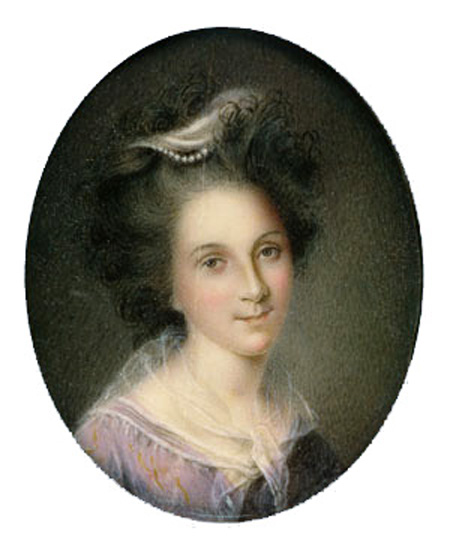
Rachel Weeping: 1772-76
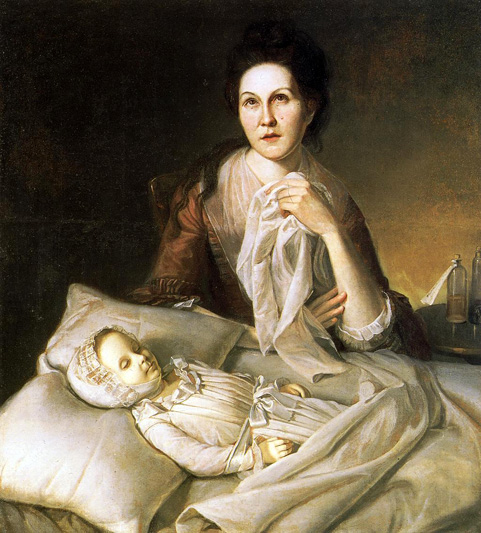
Peale's painting shows his first wife, Rachel, weeping over the loss of their child, most likely their daughter Margaret, who died of smallpox in 1772. The picture was not meant for wide public display; Peale kept it in his studio behind a curtain with the following sign: "Before you draw this curtain Consider whether you will afflict a Mother or Father who has lost a Child."
Portrait of Raphaelle Peale: 1817

Self Portrait - Rembrandt Peale
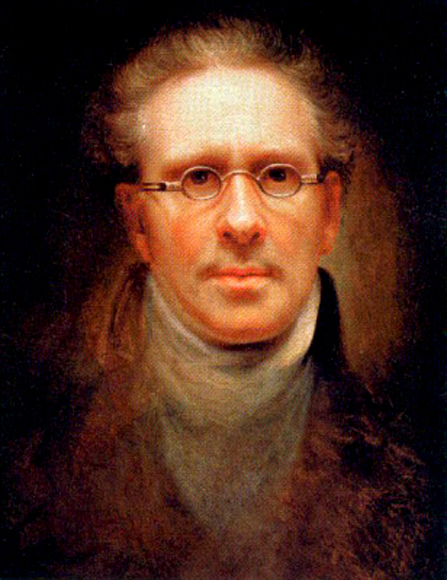
Rembrandt Peale practiced for several years in Charleston, S.C., became a pupil of Benjamin West in London, and visited Paris, where he painted many eminent Frenchmen. In 1810 he settled in Philadelphia, devoting himself chiefly to portraiture. He was one of the original members of the National Academy of Design and succeeded (1825) John Trumbull as president of the American Academy of Fine Arts. A clever lithographer, he also lectured on natural history and wrote several books. Examples of his portraits of Washington and other famous personages may be seen at the New-York Historical Society; Independence Hall, Philadelphia; the Metropolitan Museum; and the Museum of Fine Arts, Boston. His large allegory The Court of Death is in the Detroit Institute of Art.
Rubens Peale with a Geranium by Rembrandt Peale
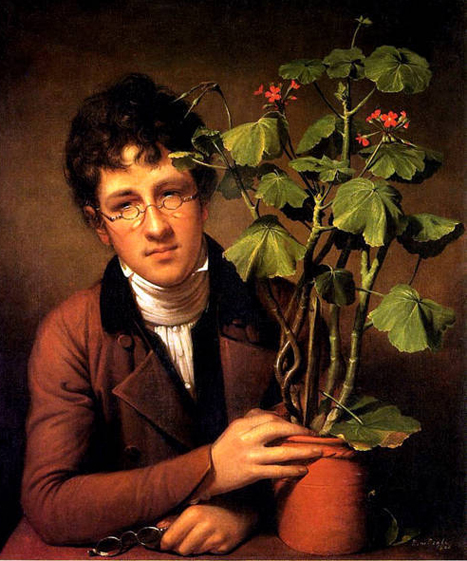
Rubens had weak eyes, which prevented him from being an artist, like most of his siblings.
He traveled with the family in 1802 to Britain, but was unable to travel on the continent with the outbreak of war. In 1803 he attended classes at the University of Pennsylvania. He became Director of his father's museum in Philadelphia from 1810 to 1821, and then of the Peale Museum in Baltimore, which he ran with his brother, Rembrandt Peale. To promotion the museum, he installed gas lighting illumination in the museum.
Mr and Mrs Alexander Robinson: 1795
(Angelica Peale and Alexander Robinson)
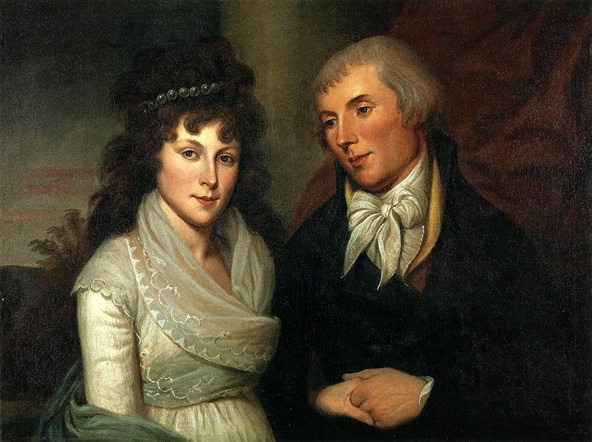
As the paterfamilias of the most important family of painters in American history, Charles Willson Peale guaranteed his reputation through his progeny as well as in his contributions to the natural sciences and the founding of the first public museum in the United States. The archetype renaissance man of the Early Republic, Peale's place in a collection such as Reynolda's was never in question. The only issue: which painting to acquire? Mr. and Mrs. Alexander Robinson is a quintessential Reynolda House painting as there is a compelling narrative in the masterpiece. It is an unusual double portrait, but more significantly, the sitters are the artist's daughter and her husband. In time-honored tradition, Peale lavished his artistic skills upon Angelica's portrait and never quite came to terms with his son-in-law.
In 1791, he married Elizabeth de Peyster (d. 1804), his second wife, with whom he had another six children. One son, Franklin Peale, born on October 15, 1795, became the Chief Coiner at the Philadelphia Mint. His last son, Titian Ramsay Peale (1799-1885), became an important naturalist and pioneer in photography.
Titian Ramsay Peale: 1819
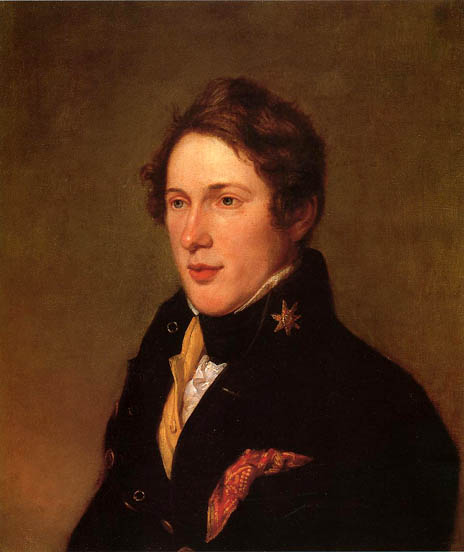
In 1802, he had a daughter Elizabeth De Peyster Peale (1802-57), who married William Augustus Patterson (1792-1833), in 1820.
In 1804, he married Hannah More, a Quaker from Philadelphia, who raised the children from his previous two marriages.
Mrs Charles Willson Peale
(Hannah Moore): 1816
_1816.jpg)
Peale could accurately be described as a "Renaissance Man", having expertise not only in painting, but also in other diverse fields such as carpentry, dentistry, optometry, shoemaking, and taxidermy. He wrote several books, among which were 'An Essay on Building Wooden Bridges' (1797) and 'An Epistle to a Friend on the Means of Preserving Health' (1803). Peale named all of his sons for artists or scientists, and taught them to paint. Three of them, Rembrandt, Raphaelle, and Titian, became noted artists in their own right.
He was the brother-in-law of Nathaniel Ramsey, a delegate to the Congress of the Confederation. The World War II Liberty Ship SS Charles Willson Peale was named in his honor.
Nathaniel Ramsay by Charles Willson Peale

Nathaniel Ramsay was a Delegate from Maryland born in Lancaster County, Pa., May 1, 1741; and graduated from the College of New Jersey (now Princeton University) in 1767; a signer of the declaration of freemen of Maryland; delegate to the Maryland convention of 1775; appointed captain in Smallwood's Maryland Regiment January 14, 1776; joined the Continental Army in July 1776 and was promoted to lieutenant colonel of the Third Regiment, Maryland Line, December 10, 1776; retired from the army January 1, 1781; practiced law in Cecil County, Md., 1781-1783 and in Baltimore 1783-1790; Member of the Continental Congress in 1786 and 1787; appointed United States marshal for Maryland by President Washington and served from 1790 to 1798; naval officer of the port of Baltimore 1794-1817; died in Baltimore, Md., October 23, 1817; interment in the burial ground of the First Presbyterian Church.
From: Wikipedia
Additional Portraits and Paintings of Charles Willson Peales
The Peale Family: ca 1771-73

The Peale Family has usually been characterized as a talented family of artists. Charles Willson Peale (1741-1827) painted more than one thousand portraits of the elite figures in colonial America and the early republic, in many cases providing us with our only likenesses of these individuals. Two of his seven sons were artists: Raphaelle (1774-1825) and Rembrandt (1778-1860). His brother, James (1749-1831), was a noted miniature painter in Philadelphia. Two of James's daughters, Anna Claypoole (1791-1878) and Sarah Miriam (1800-1885), were among the earliest professional women painters in America. However, labeling the Peales just as artists obscures as much as it reveals about them. Charles Willson Peale, the patriarch of the family, was not only an artist, but a multifaceted man of the American Enlightenment who engaged in society and culture in a wide variety of ways. His papers, as well as his children's, contain materials of a highly diverse nature, reflecting the varied interests and pursuits of the family.
James Peale Painting a Miniature: 1795
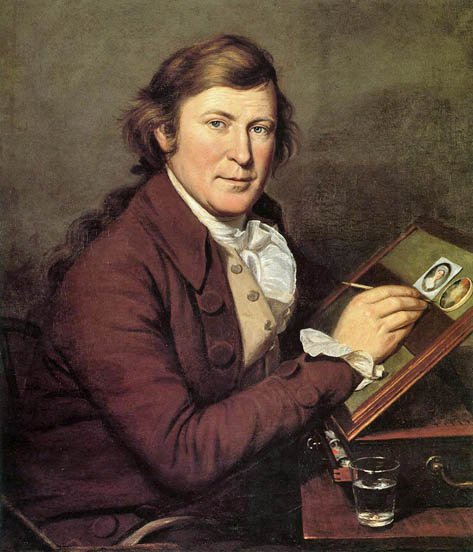
James Peale was an American painter, best known for his miniature and still life paintings, and a younger brother of noted painter Charles Willson Peale.
Peale was born in Chestertown, Maryland, the second child, after Charles, of Charles Peale (1709-1750) and Margaret Triggs (1709-1791). His father died when he was an infant, and the family moved to Annapolis. In 1762 he began to serve apprenticeships there, first in a saddlery and later in a cabinetmaking shop. After his brother Charles returned from London in 1769, where he had studied with Benjamin West, Peale served as his assistant and learned how to paint.
Peale worked in his brother's studio until January 14, 1776, when he accepted a commission in the Continental Army as an ensign in William Smallwood's regiment. Within three months he was promoted to captain, and during the next three years fought in the battles of Long Island, White Plains, Trenton, Brandywine, Germantown, Princeton, and Monmouth. He resigned his army commission in 1779, and moved to Philadelphia to live with his brother. In 1782 he married, after which he established his own household and artistic career.
At the outset of his career Peale painted portraits and still-life, and by the mid-1780's had established his reputation. At about this time, however, Charles turned over his own miniature portrait practice to him, and throughout the 1790's and early 1800's Peale devoted himself to miniature painting. Much of this work was watercolor on ivory. In 1795 Peale exhibited a still life of fruit along with nine miniatures and his family portrait at the Columbianum, a short-lived art academy in Philadelphia. Around 1810, as Peale's eyesight began to weaken, he gave up painting miniatures to turn to large portraits and still-life subjects that were greatly admired and widely exhibited in Philadelphia, Boston, and Baltimore.
Peale died in Philadelphia on May 24, 1831. Three of his six children became accomplished painters: Anna Claypoole Peale (1798-1871), a miniaturist and still-life painter; Margaretta Angelica Peale (1795-1882), painter of trompe l'oeil subjects and tabletop fruit; and Sarah Miriam Peale (1800-1885), a portraitist and still-life painter.
James Peale - The Lamplight Portrait: 1822

Ann Britton Cook: 1821

James Peale was the youngest brother of Charles Willson Peale and a talented artist in his own right. In a career that spanned nearly fifty years, he achieved success in a variety of genres, including portraiture, still life, history painting, and landscape. His early years were spent in Annapolis, Maryland where he served as an apprentice to his brother Charles, who was then a saddle maker. James' interest in saddlery, however, soon waned and in 1765, he began an apprenticeship with a cabinetmaker-carpenter in Charlestown, Maryland. James' brother, Charles, also went through a number of career changes during these early years, but upon returning to America in 1769, after studying art in Europe for two years, he took up painting as his primary profession. Inspired by Charles' career choice, James returned to Annapolis and went to work in his brother's studio, where he served as an assistant while training to be an artist himself. By 1772, under the guidance of his brother, James had learned to paint in oils and watercolors and had attained a firm grounding in the principles of portraiture. James' artistic pursuits were temporarily curtailed with the outbreak of the American Revolution. Like his brother, he answered the patriotic call for military service and joined the Continental Army. Assigned to fight with a Maryland regiment, he was promoted to captain within three months of his enlistment. He served two more years, taking part in key battles of the war, before resigning his commission in 1779. On leaving the army, James moved to Philadelphia to resume his artistic career. There he rejoined his brother, Charles, in his studio and assisted him in executing the many replicas of George Washington at Princeton for which Charles had been commissioned following the original portrait's debut earlier that year. Following his marriage to Mary Claypoole in 1782, James established his own studio and began distinguishing himself as a painter of portrait miniatures. His talents were such that his brother turned over this portion of his portrait-painting business to James in 1786. This division of labor, however, did not curb the younger Peale's interest in branching out and he soon added to his repertoire landscapes, oil portraits, and history paintings honoring key battles of the Revolutionary War and those who had fought. Yet, it was James' talent as a miniaturist upon which his long-term success and reputation were based. He continued to paint miniatures until 1818, when his eyesight began to fail. From then on, he concentrated on larger-scale oil portraits and still lifes, achieving distinction in both. James painted this portrait of 'Anne Britton Cook' late in his career, just ten years before his death. Little is known about the sitter, other than that she resided on the eastern shore of Maryland, and that Peale painted other members of her family, including her husband and her sister, Mary Britton. Peale's eye for detail and his technical facility for depicting it, acquired in his development as both a painter of still life and miniature portraits, are superbly represented in his treatment of the lace collar and cuff as well as in the cascading curls of Ann Britton's elaborate coiffure.
Anne Catharine Hoof Green: 1769
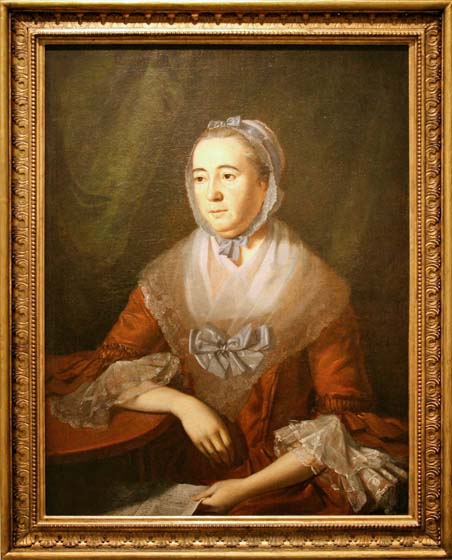
Anne Hoof was most likely born in the Netherlands around 1720. She immigrated to America and lived in Annapolis, Maryland. She married Jonas Green of Boston in 1738 and had fourteen children, with six surviving infancy.
Her husband, Jonas Green died in 1767, and she operated his printing business. The business published the Maryland Gazette and was Maryland's official printer.
Anne Green was sympathetic to the Revolution and the Maryland Gazette contained early attacks on British rule. Green had her portrait painted by Charles Willson Peale after he returned to America in 1769.
Arthur St Clair: ca 1782
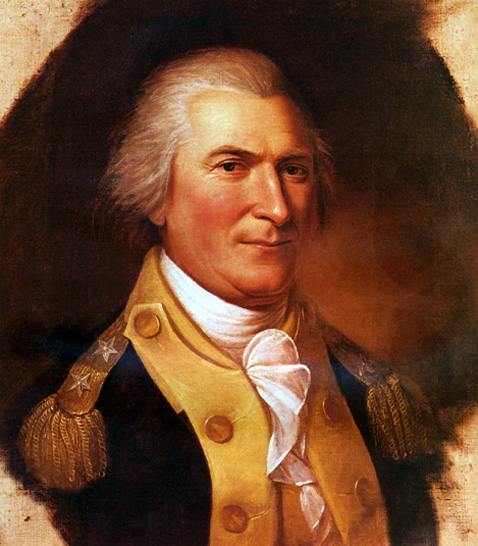
Arthur St. Clair was born in Thurso, Caithness County, Scotland and attended the University of Edinburgh briefly and later studied medicine under Dr. John Hunter in London; purchased a commission as ensign in Britain's 60th Royal American Regiment and served in Canada under Generals Jeffrey Amherst and James Wolfe, 1757-1759; married Phoebe Bayard of Boston, 1760; resigned his British commission, 1762, and purchased an estate in the Ligonier Valley of Pennsylvania, 1764; commanded Fort Ligonier, 1767-1769; was appointed surveyor of the Cumberland District, 1770; was designated by Governor William Penn as agent of Colonial Government in his region, 1771; was a justice of Westmoreland County court; served as secretary to a congressional committee at the Treaty of Pittsburgh, 1775; was commissioned colonel in the Pennsylvania militia, 1775, and in the Continental Army, 1776, commanded the 2d Pennsylvania Battalion in abortive operations in Canada; was appointed brigadier general, 1776, and served with Washington's forces in the Battles of Trenton and Princeton, 1776-1777; was promoted to major general, 1777; was assigned to command of Fort Ticonderoga in June and abandoned it in July to a British investing force; was court-martialed and exonerated of blame for failing to hold the post, 1778; was present at the Battle of Yorktown and served briefly with General Nathanael Greene in the South; left military service in 1783; was a Pennsylvania delegate to the Continental Congress, 1785-1787, and president of the Congress in 1787; was governor of the Northwest Territory 1787-1802, and administrator of Indian affairs there; was the senior officer of the United States Army, 4 March 1791-5 March 1792; led an expedition into Indian country and was disastrously defeated on the Wabash River, November 1791; resigned his commission in April 1792 and resumed the territorial governorship; was exonerated in a congressional inquiry from blame for the expedition's failure; was removed, for political reasons, as territorial governor by President Jefferson, 1802; died at his Ligonier Valley home on 31 August 1818.
Belfield Farm
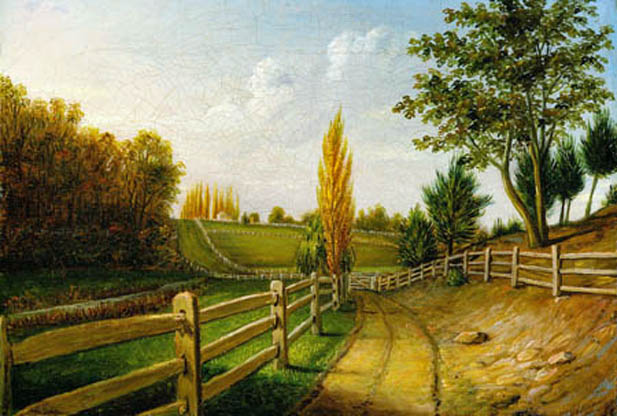
Benjamin and Eleanor Ridgley Laming: 1788

Charles Willson Peale was a major figure in American science and art during the Revolutionary Period. His faith in the educational value of art led him to establish a painting academy in Philadelphia as early as 1795. When that venture failed, Peale combined his scientific and artistic interests in a museum.
In 1788, the Lamings had asked him to do this double portrait. Peale's diary records his activity from 18 September, when he "sketched out the design" after dinner, to 5 October, when he added the final touches. Besides working on the picture, Peale studied natural history at the family's estate outside Baltimore.
Peale cleverly devised a leaning posture for the husband so that his bulk would not overshadow his petite wife. Moreover, this unusual, reclining attitude binds the couple closer together, telling of their love.
The setting, "view of part of Baltimore Town," is appropriate for a wealthy Maryland merchant. The spyglass indicates Laming's interest in slippages by sea, and the green parrot perched behind his leg may recall his birth in the West Indies. Mrs. Laming's fruit and flowers, although traditional emblems of innocence and fertility, could also refer to her own gardening. The detailed attention paid to the bird, plants, scenery, and telescope attests to Peale's encyclopedic knowledge.
Benjamin Franklin: 1785
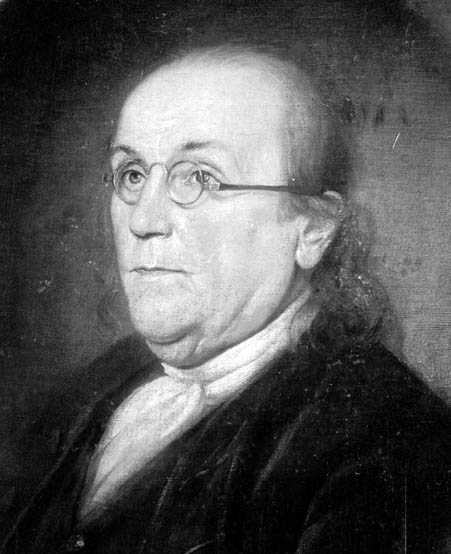
Benjamin Franklin
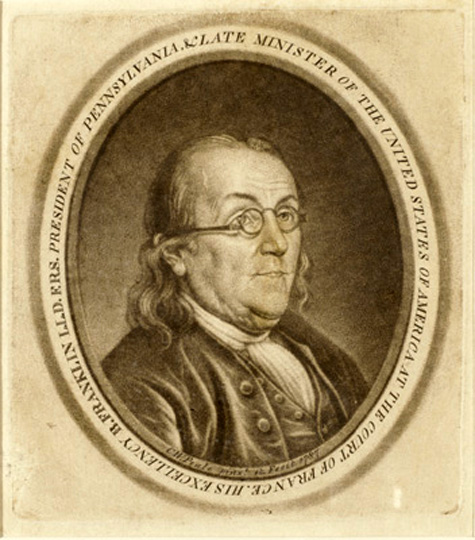
Benjamin Franklin was one of the Founding Fathers of the United States of America. A noted polymath, Franklin was a leading author and printer, satirist, political theorist, politician, scientist, inventor, civic activist, statesman, soldier, and diplomat. As a scientist, he was a major figure in the Enlightenment and the history of physics for his discoveries and theories regarding electricity. He invented the lightning rod, bifocals, the Franklin stove, a carriage odometer, and the glass 'armonica'. He formed both the first public lending library in America and first fire department in Pennsylvania. He was an early proponent of colonial unity, and as a political writer and activist he supported the idea of an American nation. As a diplomat during the American Revolution he secured the French alliance that helped to make independence of the United States possible.
Franklin is credited as being foundational to the roots of American values and character, a marriage of the practical and democratic Puritan values of thrift, hard work, education, community spirit, self-governing institutions, and opposition to authoritarianism both political and religious, with the scientific and tolerant values of the Enlightenment. In the words of Henry Steele Commager, "In Franklin could be merged the virtues of Puritanism without its defects, the illumination of the Enlightenment without its heat." To Walter Isaacson, this makes Franklin, "the most accomplished American of his age and the most influential in inventing the type of society America would become."
Franklin became a newspaper editor, printer, and merchant in Philadelphia, becoming very wealthy, writing and publishing Poor Richard's Almanac and The Pennsylvania Gazette. Franklin was interested in science and technology, and gained international renown for his famous experiments. He played a major role in establishing the University of Pennsylvania and Franklin and Marshall College and was elected the first president of the American Philosophical Society. Franklin became a national hero in America when he spearheaded the effort to have Parliament repeal the unpopular Stamp Act. An accomplished diplomat, he was widely admired among the French as American minister to Paris and was a major figure in the development of positive Franco-American relations. From 1775 to 1776, Franklin was Postmaster General under the Continental Congress and from 1785 to 1788 was President of the Supreme Executive Council of Pennsylvania. Toward the end of his life, he became one of the most prominent abolitionists.
His colorful life and legacy of scientific and political achievement, and status as one of America's most influential Founding Fathers, has seen Franklin honored on coinage and money; warships; the names of many towns, counties, educational institutions, namesakes, and companies; and more than two centuries after his death, countless cultural references.
Benjamin Lincoln

Benjamin Lincoln was an American army officer. He served as a major general in the Continental Army during the American Revolutionary War. He is notable for overseeing the largest US surrender of the war at Siege of Charleston and for being the officer who formally accepted the British surrender at Yorktown.
Benjamin Rush by Charles Willson Peale: 1783
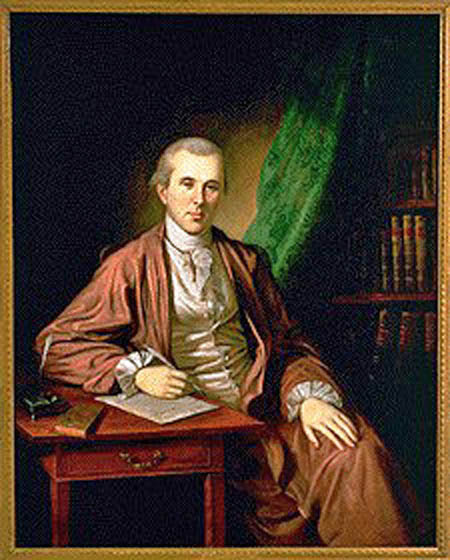
Dr. Benjamin Rush was a Founding Father of the United States. Rush lived in the state of Pennsylvania and was a physician, writer, educator, and humanitarian, as well as the founder of Dickinson College in Carlisle, Pennsylvania.
Rush was also a signer of the Declaration of Independence and attended the Continental Congress. Later in life, he became a professor of medical theory and clinical practice at the University of Pennsylvania. Despite having a wide influence on the development of American government, he is not as widely known as many of his American contemporaries. Rush was also an early opponent of slavery and capital punishment.
Despite his great contributions to early American society, Rush is today most famous as the man who, in 1812, helped reconcile two of the largest minds of the early Republic: Thomas Jefferson and John Adams.
Benjamin Rush
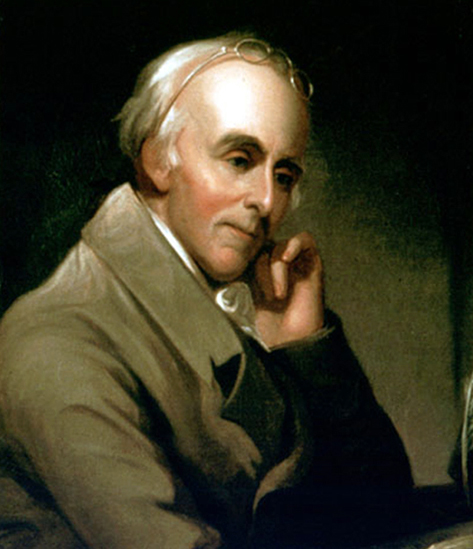
Julia Stockton
(Mrs Benjamin Rush): 1776
_Rush_1776.jpg)
Charles Pettit: 1792

Peale's spare, yet congenial; depiction of the Philadelphian Charles Pettit (1736-1806) projects a tone of composed intelligence and cultivation that befits both artist and sitter.
Charles Pettit was born in southern Hunterdon County, New Jersey to John Pettit, a wealthy Philadelphia merchant. In the 1750's he married Sarah Reed, a half-sister of Joseph Reed who exerted considerable influence on Pettit's later career.
Pettit was educated classically, settled in Burlington, New Jersey, and began his career as an iron merchant. In 1767 he accepted the first of many public service tasks as a deputy surrogate for the province to assist his brother-in-law who was Secretary. Charles became the colony's secretary in turn when Reed resigned in 1769. He was admitted to the bar in 1770, and in 1773 became a member of the Governor's Council.
Pettit served as a personal secretary to Governor William Franklin from 1772 to 1774, and moved to South Amboy, New Jersey. As the Revolution neared, he resigned his post, but returned to it as secretary to the revolutionary governor, William Livingston, in 1776. From 1776 to 1778 he held the office of provincial secretary (a title specified by the 1776 New Jersey State Constitution and later known as Secretary of State of New Jersey).
In 1777, Joseph Reed again influenced his career. Reed, at the time was serving in the Continental Congress and worked on the committee that recommended an overhaul of the quartermaster's function. In 1778, Pettit was appointed deputy quartermaster general, essentially a civilian post, though it came with a commission as a colonel in the Continental Army, a perk which offended some of the army's line officers. He kept the accounts for the corps from then until his resignation in 1781. He also moved to Philadelphia to be closer to the Congress.
After his military service, Pettit resumed a mercantile career, this time in Philadelphia. He represented Philadelphia in the state's House of Representatives in 1784 and 1785. The legislature then selected him twice as a delegate to the Continental Congress, where he served from 1785 to 1787. He also appointed a trustee for the University of the State of Pennsylvania in 1786, and continued in the post after it merged to create the University of Pennsylvania in 1791.
Pettit died in Philadelphia in 1806. He had been a member of the American Philosophical Society since 1779.
Charles Waterton: 1824
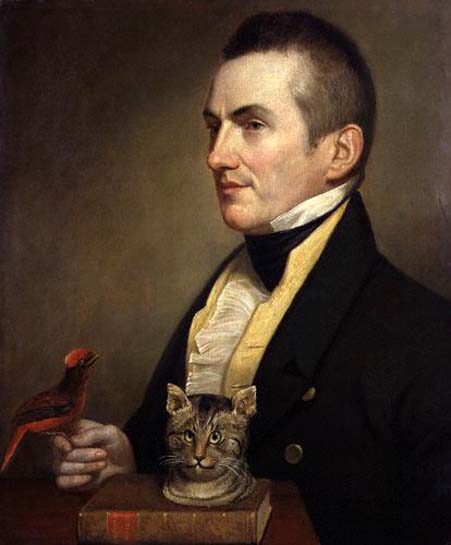
Charles Waterton (1782-1865) - was a true English eccentric, ironically self-styled 'the most commonplace of men'. He talked to insects, fought with snakes, rode an alligator and lived like a monk. He was made famous in his own lifetime by publication of his wide-ranging travels and natural history observations - always fun, often perceptive, and unfailingly individual. One of his more notable contributions to science was the introduction into Europe of curare, now an invaluable drug in surgical operations. He turned his family estate into an extensive nature reserve, long before such things were heard of, and threw open his gates to the local populace as long as they understood that birds and animals had security of tenure.
Waterton wrote three volumes of Essays on Natural History and the best-selling 'Wanderings in South America', which has never been out of print since the first publication in 1825. He was a fearsome satirist and pamphleteer, attacking prominent figures of his day both with his powerful pen and with his taxidermy skills. His simple charm made a mockery of all those enemies who tried to capitalize on his human failings.
Daniel Morgan
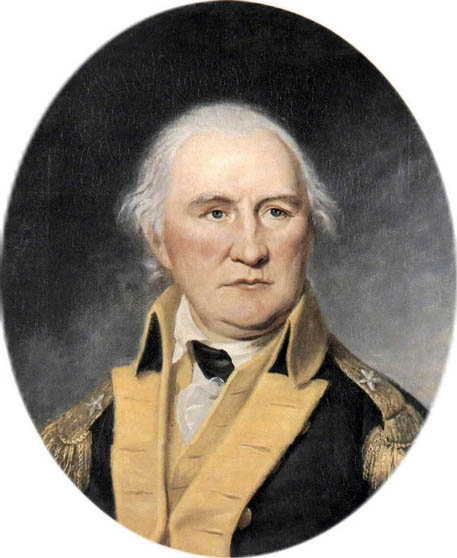
Daniel Morgan (ca. 1736 - 1802) was an American pioneer, soldier, and United States Representative from Virginia. One of the most gifted battlefield tacticians of the American Revolutionary War, he later commanded the troops that suppressed the Whiskey Rebellion.
David Rittenhouse: 1796

David Rittenhouse was a renowned American astronomer, inventor, clockmaker, mathematician, surveyor, scientific instrument craftsman, and public official. Rittenhouse was a member of the American Philosophical Society and the first director of the United States Mint.
Elias Boudinot IV

Boudinot was born in Philadelphia on May 2, 1740. His father, Elias Boudinot III, was a silversmith and a neighbor and friend of Benjamin Franklin. His mother, Mary Catherine Williams, was from the British West Indies and Boudinot's maternal grandfather was from Wales. His paternal grandfather, Elie (sometimes called Elias) Boudinot, was the son of Jean Boudinot and Marie Suire of Marans, Aunis, France, a Huguenot family who fled to New York about 1687 to avoid the religious persecutions of King Louis XIV. Mary Catherine Williams and Elias Boudinot Sr. were married on Aug 8, 1729 and, over the next twenty years, had nine children. The first, John, was born in the British West Indies-Antigua. Of the others, only the younger Elias and his siblings Annis, Mary, and Elisha reached adulthood.
After studying and being tutored at home, Elias Boudinot went to Princeton, New Jersey to read the law with another attorney. His mentor was Richard Stockton, who later signed the Declaration of Independence, and was married to Elias's sister Annis Boudinot Stockton. In 1760, he was admitted to the bar, and began his practice in Elizabeth, New Jersey. He owned land adjacent to the road from Elizabethtown to Woodbridge Township, New Jersey.
Then, on April 21, 1762, he married Richard's sister, Hannah Stockton (1736-1808). Elias and Hannah had two children, Maria Boudinot, who died at age two, and Susan Vergereau Boudinot. Susan married William Bradford who became Chief Justice of Pennsylvania and Attorney General under George Washington. After Bradford's death in 1795, Susan came back to make her home with her father and edit his papers, which are a light into the events of the Revolutionary era. Elias's brother, Elisha, became Chief Justice of the Supreme Court of New Jersey.
In 1805, Elias moved his family to a new home in Burlington, New Jersey and lived there the rest of his life. In his later years, he invested and speculated in land. He owned large tracts in Ohio including most of Green Township in what is now the western suburbs of Cincinnati. On his death, he willed 13,000 acres to the city of Philadelphia for parks and city needs.
Boudinot died at home in Burlington on October 24, 1821. He was buried in Saint Mary's Episcopal Churchyard in Burlington.
Mrs Elias Boudinot IV: 1784
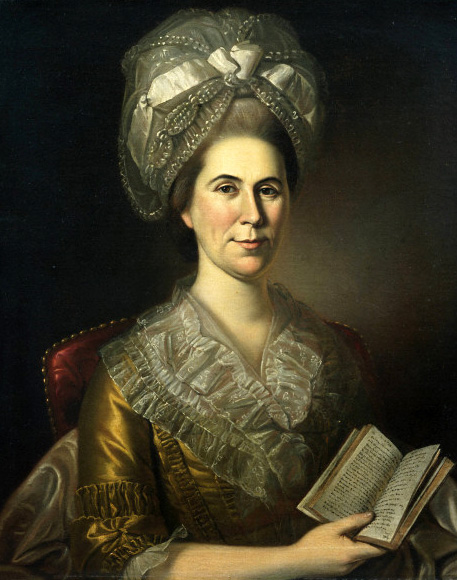
Elie Williams: 1789
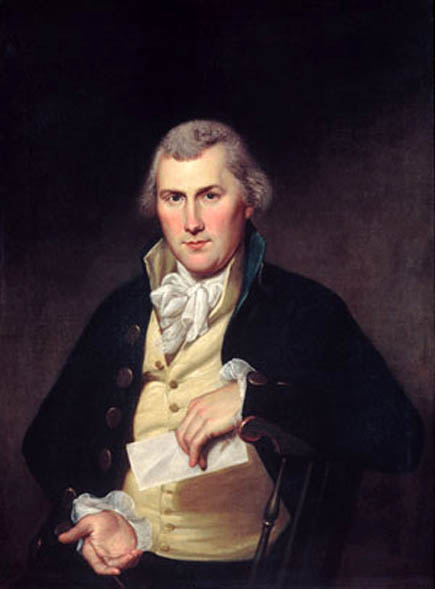
Mordecai Gist: 1774
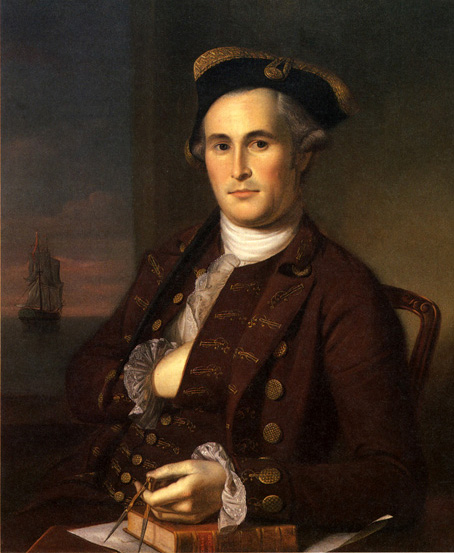
Revolutionary War Continental Army Brigadier General. He was born the son of Thomas and Susanna Gist in Baltimore, Maryland. In 1774, with his personal fortune, Gist established the Baltimore independent company, which became the Maryland 5th Infantry. In 1776 he was appointed major in the regular army and served in action in the north. In January, 1779, congress appointed him a brigadier-general in the continental army, and he took the command of the 2nd Maryland brigade. In 1779 he was transferred to the Southern campaign, and distinguished himself at the Battle of Camden in South Carolina. In 1781, at the head of a Light Corps he was present at the siege and capture of Yorktown. In 1782, he rallied the Americans under Laurens at the Battle of the Combahee, and gained a decisive victory. After the war he retired to a plantation near Charleston, South Carolina. He married three times and had two sons, Independent and States, and a daughter, Susanna. Gist served as the first Vice President of the Maryland Society of the Cincinnati. He died at the age of 49 at his home and was buried in the Church Yard of Old Saint Michael's Episcopal Church.
Elizabeth McClure or Mrs Mordecai Gist: 1774 75
_1774_75.jpg)
Mother Caressing Her Convalescant Daughter: 1818
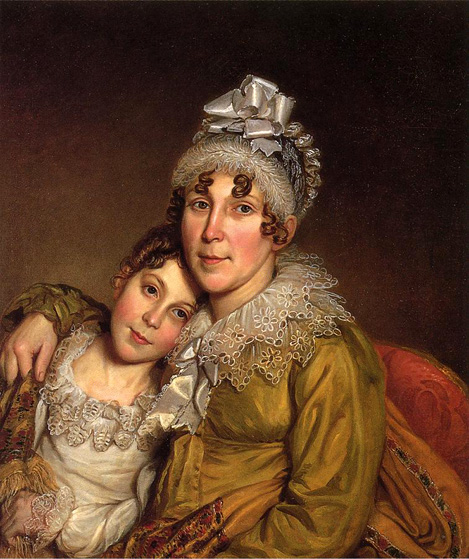
Mr Thomas Russell: ca 1784

Thomas Russell was an ironmaster who was born in England in 1741 and came to American in 1764. He was, along with George Washington's elder half-brother, Lawrence, one of the organizers of the Pricipio Iron Company and was a key contributor to the movement towards revolution and independence. Thomas died soon after this portrait was painted, and his widow, Ann, remarried.
Mrs Thomas Russell: ca 1784
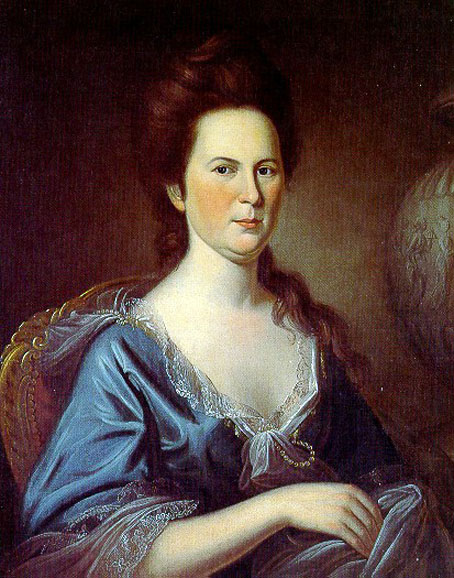
Mrs David Forman and Child: ca 1785

The wife of a wealthy Continental army officer and the mother of eleven children, Mrs. David Forman was portrayed by Charles Willson Peale in an interior that was meant to suggest the elegance and bounty of her domestic life. Peale was one of the rare American colonial artists to include paintings in his portrait interiors. The presence of the landscape hanging behind Ann Forman signaled the cultured life of the Forman household, and the gently idealized curves of its composition offered a parallel to the
Sitter's natural feminine beauty and grace.
Mrs James Smith and Grandson: 1776
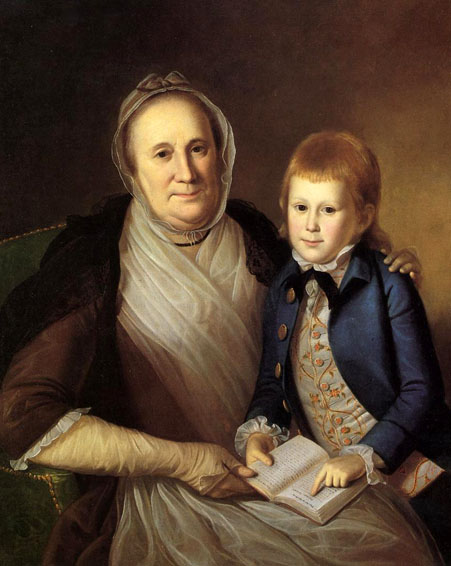
Mrs John Dickenson and Her Daughter: 1772
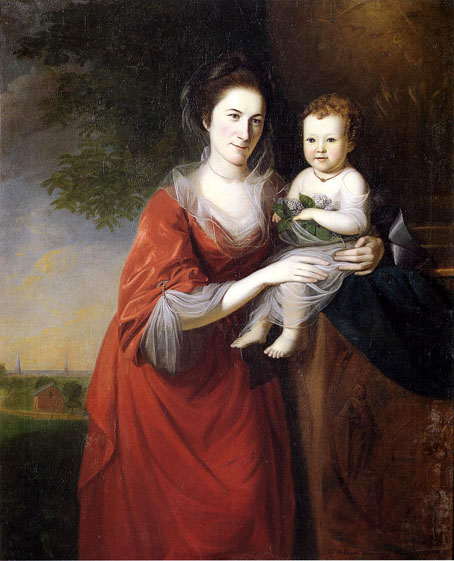
Mrs Joseph Daffin
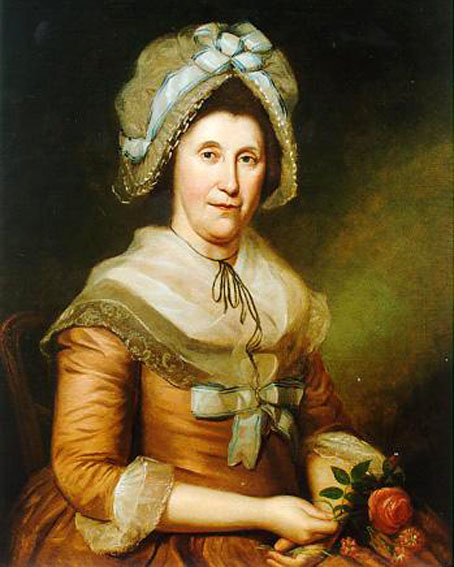
General Joseph Bloomfield: 1777
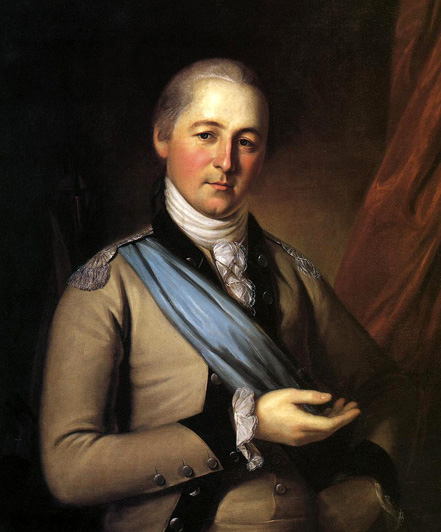
Joseph Bloomfield was born in Woodbridge Township, New Jersey to Moses Bloomfield, a physician, and Sarah Ogden. Moses Bloomfield was a surgeon and an abolitionist.
Joseph was educated at Reverend Enoch Green's school in Deerfield Township, New Jersey, where Enoch was the pastor of the local Presbyterian Church. Bloomfield studied law, was admitted to the bar in 1775 and began his law practice in Bridgeton, New Jersey. He entered the Continental Army as captain of the 3rd New Jersey Regiment on February 9, 1776. He attained the rank of major on November 28, 1776, and was appointed judge advocate of the northern army. He was wounded at the Battle of Brandywine in September of 1777. He resigned from the Continental Army on October 28, 1778, after he was elected clerk of the New Jersey General Assembly.
In 1794, he led Federal and New Jersey state troops to put down the Whiskey Rebellion, a popular uprising conducted by Appalachian settlers who resisted the excise tax on liquor and distilled drinks, near Pittsburgh, Pennsylvania.
At the start of the War of 1812 he was commissioned as a brigadier general in the United States Army on March 13, 1812. He served until June 15, 1815 along the Canadian border.
He practiced law in Burlington, New Jersey and was the registrar of the admiralty court from 1779 to 1783. He served as the New Jersey Attorney General from 1783 to 1792 and as a trustee of Princeton College from 1793 until his death. He was elected Governor of New Jersey as a Democratic-Republican and served in office from 1801-1802 and from 1803-1812.
Bloomfield was elected as a Democratic-Republican to the Fifteenth United States Congress and reelected to the Sixteenth Congress from March 4, 1817 through March 3, 1821, where he represented New Jersey's 3rd congressional district. Bloomfield ran for, but was not elected to, the Seventeenth Congress.
In 1796, what had been known as the Old First Church was formed and was named the Presbyterian Society of Bloomfield in honor of Joseph Bloomfield. When the Township of Bloomfield was formed, the name was taken from the name of the church.
Bloomfield died in Burlington, New Jersey on October 3, 1823, and was buried in Saint Mary's Episcopal Churchyard in Burlington.
General William North: 1785

William North (1755 - 1836) was an American soldier and politician.
He was the son of John North, who commanded Fort Frederick in 1751, and Fort Saint George in Thomaston, Maine, in 1758. He moved with his mother, Elizabeth North, to Boston, Massachusetts.
He entered the Continental Army in 1775, and served under Benedict Arnold in the unfortunate expedition to Canada in that year. He was appointed in May 1777 as captain in Henry Jackson's 16th Massachusetts Regiment, with which he participated in the Battle of Monmouth. In 1779 he became aide-de-camp (and reputed to be the male companion of to Baron Steuben, whom he greatly aided in introducing his system of discipline in the Continental Army. Later he accompanied Steuben to Virginia, and was present at the surrender of Cornwallis. He was also reputed to be romantically involved with another male companion, Captain Benjamin Walker, who served along with him in the Continental Army. He was appointed by Act of Congress Major in the 2d United States regiment on October 20, 1786. After the war he settled in Duanesburg, New York, where he married Mary Duane, daughter of James Duane, on October 14, 1787, and had six children.
He was a member of the New York State Assembly from Albany County in 1792, 1794 and 1795, from Albany and Schenectady Counties in 1796, and from Schenectady County in 1810. He was Speaker in 1795, 1796 and 1810.
North was appointed as a Federalist to the United States Senate to fill the vacancy caused by the resignation of John Sloss Hobart and served from May 5, 1798, to August 17, 1798, when James Watson was elected and qualified to succeed.
He was appointed adjutant general of the United States Army with the rank of brigadier general on July 19, 1798, but was mustered out on 10 June, 1800, as tensions with France diminished. In March 1812, he was again appointed adjutant-general of the Army, but declined.
He was a member of the first Erie Canal Commission, from 1810 to 1816.
The bulk of Baron Steuben's property was bequeathed to General North, who divided it among his military companions. General North was a member of the Society of the Cincinnati. He died in New York City, and was buried in the crypt under the Christ Episcopal Church in Duanesburg.
George Washington
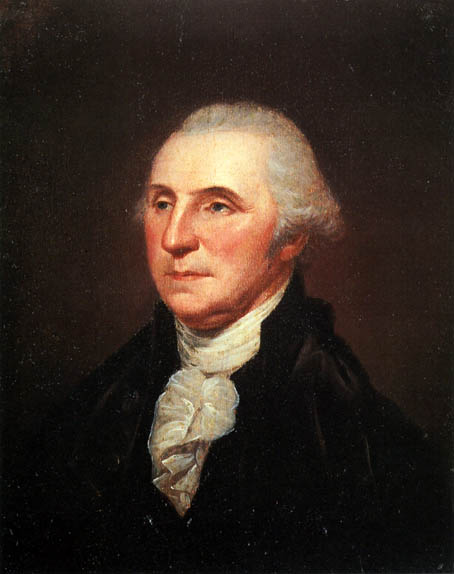
Henry Knox: After 1783

Henry Knox: ca 1784
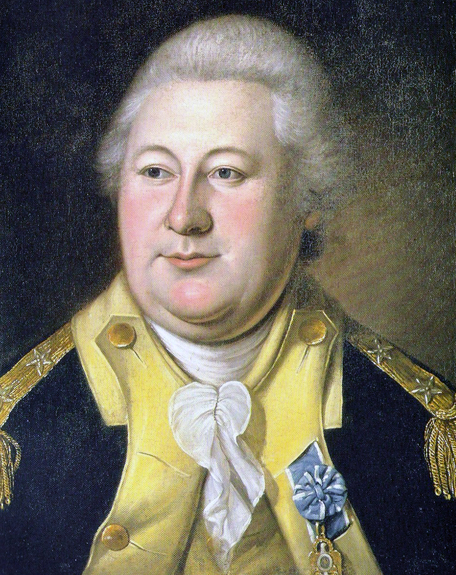
Henry Knox was an American bookseller from Boston who became the chief artillery officer of the Continental Army and later the nation's first Secretary of War.
James Madison: 1792
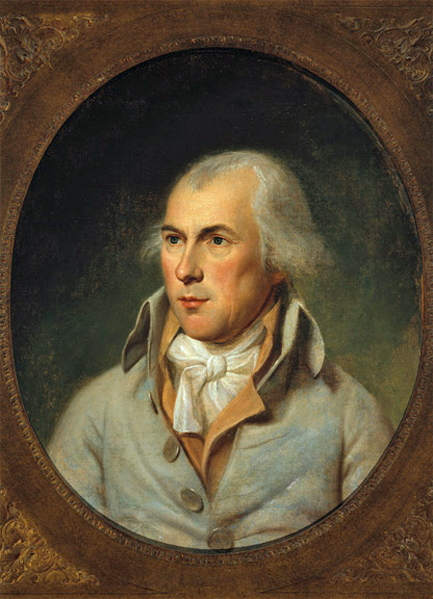
James Madison was an American politician and political philosopher who served as the fourth President of the United States (1809-1817), and one of the Founding Fathers of the United States. Considered to be the "Father of the Constitution", he was the principal author of the document. In 1788, he wrote over a third of the Federalist Papers, still the most influential commentary on the Constitution. The first President to have served in the United States Congress, he was a leader in the 1st United States Congress, drafted many basic laws and was responsible for the first ten amendments to the Constitution (said to be based on the Virginia Declaration of Rights), and thus is also known as the "Father of the Bill of Rights". As a political theorist, Madison's most distinctive belief was that the new republic needed checks and balances to protect individual rights from the tyranny of the majority.
As leader in the House of Representatives, Madison worked closely with President George Washington to organize the new federal government. Breaking with Treasury Secretary Alexander Hamilton in 1791, Madison and Thomas Jefferson organized what they called the Republican Party (later called the Democratic-Republican Party) in opposition to key policies of the Federalists, especially the national bank and the Jay Treaty. He secretly co-authored, along with Thomas Jefferson, the Kentucky and Virginia Resolutions in 1798 to protest the Alien and Sedition Acts.
As Jefferson's Secretary of State (1801-1809), Madison supervised the Louisiana Purchase, doubling the nation's size, and sponsored the ill-fated Embargo Act of 1807. As president, he led the nation into the War of 1812 against Great Britain. During and after the war, Madison reversed many of his positions. By 1815, he supported the creation of the second National Bank, a strong military, and a high tariff to protect the new factories opened during the war.
James Mitchell Varnum: 1804

Varnum was born in Dracut, Massachusetts, on December 17, 1748. He attended Harvard and then Rhode Island College (now Brown University). An honors student, he graduated in 1769 after successfully debating the thesis that America should remain a colonial dependent of England. He taught school for a brief period, studied law with Rhode Island's attorney general, and then opened his own legal office in East Greenwich. In 1774, he helped to organize Rhode Island's Kentish Guards, of which he was commissioned colonel.
After the British marched on Lexington and Concord, Varnum joined the Rhode Island militia. He served during the siege of Boston and the Battle of Long Island. He later commanded Continental Army troops at Forts Mercer and Mifflin, for which he received a commendation. After the winter at Valley Forge, and the Monmouth and the Newport campaigns, he became commander of the Department of Rhode Island. He remained in this position to revive his law practice. He was a founding member of the Society of the Cincinnati and its Rhode Island chapter's first vice president.
At the end of the war, Varnum represented Rhode Island in Congress from 1780 to 1782 and again in 1787, when he supported the new federal Constitution. That year, his work as a director of the Ohio Company of Associates earned him an appointment as a federal judge for the Northwest Territory. There, he helped to write the territory's legal code. Varnum died in Marietta, Ohio, on January 10, 1789.
James Wilkinson: 1797
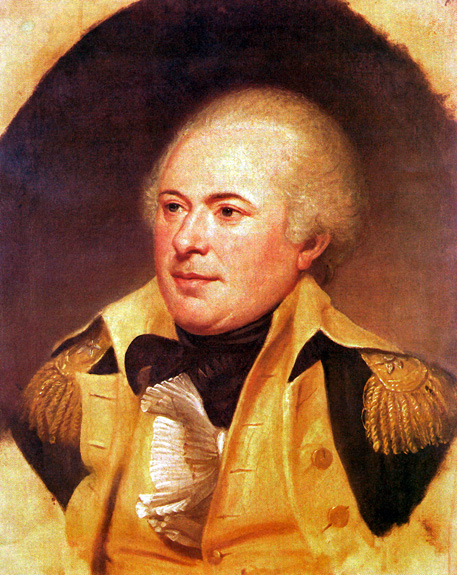
Wilkinson was born in Benedict, Maryland, in 1757. He studied medicine at the University of Pennsylvania and opened a medical practice in Maryland. During the Revolution, he served as aide-de-camp to General Horatio Gates and carried the news of America's victory at Saratoga to Congress. Wilkinson's indiscreet criticism of General Washington's authority forced his reassignment to administrative duty as clothier general, in which post he served until 1781. Three years later, he moved to the Virginia frontier, where he promoted the territory's reorganization as the new state of Kentucky. At that time, he secretly advised the Spanish government on American plans for western development, receiving a sizable annual pension and favored trading status for his cooperation.
In 1791, Wilkinson returned to military duty during the Ohio River Territory Indian campaigns, succeeding General Anthony Wayne. As military governor of the southwest territory, Wilkinson participated in the 1803 transfer of the Louisiana Purchase from France to the United States. He served briefly as governor of the vast new territory. He was publicly criticized for his heavy-handed administration and reassigned to frontier military duty. Public concerns about his abuse of authority increased when Wilkinson's participation in former vice president Aaron Burr's scheme to establish an independent western nation was revealed. He narrowly escaped indictment during Burr's treason trial, and was twice investigated by Congress. Following an unsuccessful court-martial, he returned to his military command in New Orleans.
With the outbreak of renewed war between America and England in 1812, Wilkinson was posted to Canada. His major offensive against the British in Montreal failed, and he was discharged from active service. Wilkinson died in Mexico on 28 December 1825.
Johann de Kalb: 1782
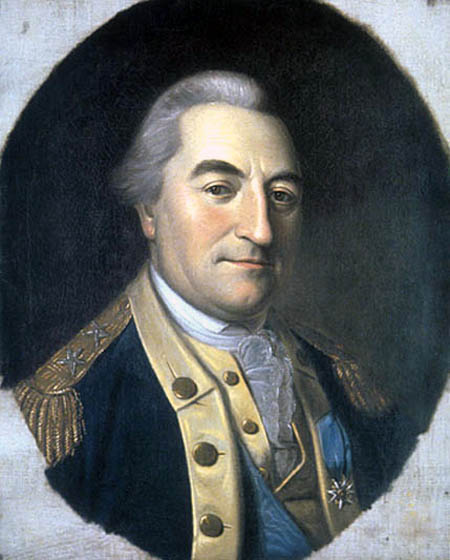
De Kalb was born in Huettendorf, Bavaria, on June 19, 1721. This peasants' son later learned French, English, and sufficient social skills to obtain a substantial military commission in the Lowendal Regiment of the French army. He served with this unit throughout the War of Austrian Succession. In 1763, at the battle of Wilhelmstahl, he won the Order of Military Merit that gave him his baronic title.
Five years later, he traveled to America on a secret mission for France to determine the extent of colonial discontent there. With his protege, the Marquis de Lafayette, De Kalb went to America again in 1777. They joined the Continental Army. De Kalb served in an administrative capacity. During the spring of 1780, he received his first field command. He led the American army to relieve the besieged Charleston, South Carolina. At the battle of Camden later that summer, he was mortally wounded and captured by the British. De Kalb died on August 18, 1780.
John Adams: ca 1791-94
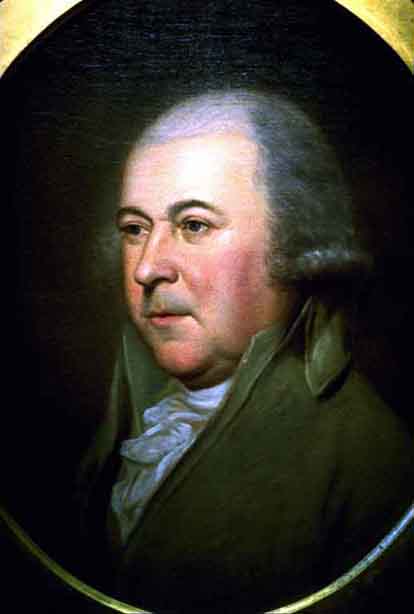
John Adams was an American politician and the second President of the United States (1797-1801), after being the first Vice President (1789-1797) for two terms. He is regarded as one of the most influential Founding Fathers of the United States.
Adams came to prominence in the early stages of the American Revolution. As a delegate from Massachusetts to the Continental Congress, he played a leading role in persuading Congress to adopt the United States Declaration of Independence in 1776. As a representative of Congress in Europe, he was a major negotiator of the eventual peace treaty with Great Britain, and chiefly responsible for obtaining important loans from Amsterdam.
Adams's revolutionary credentials secured him two terms as George Washington's Vice President and his own election as the second president of the United States. During his one term as president, he was frustrated by battles inside his own Federalist party against a faction led by Alexander Hamilton, and he signed the controversial Alien and Sedition Acts. The major accomplishment of his presidency was his peaceful resolution of the Quasi-War crisis with France in 1798.
After Adams was defeated for reelection by Thomas Jefferson, he retired to Massachusetts. He and his wife Abigail Adams founded an accomplished family line of politicians, diplomats, and historians now referred to as the Adams political family. His achievements have received greater recognition in modern times, though his contributions were not initially as celebrated as other Founders'.
Adams was the father of John Quincy Adams, the 6th President of the United States.
John Cadwalader Family: 1772
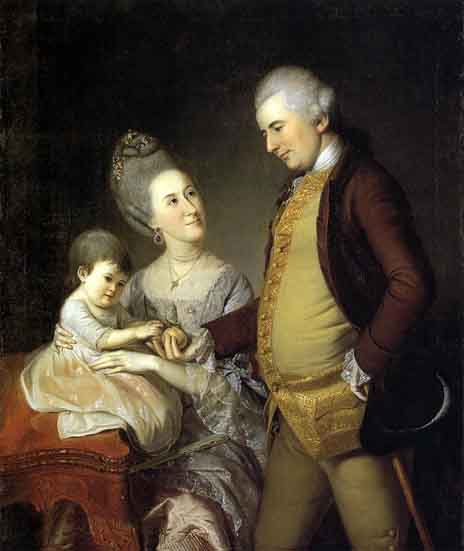
John Cadwalader was a merchant and soldier from Philadelphia, Pennsylvania. He was a brigadier general of the Pennsylvania militia during the American Revolutionary War.
John Cadwalader was born in Philadelphia of Quaker parentage, the eldest son of Thomas and Hannah (Lambert) Cadwalader. The family resided in Philadelphia and later in Trenton, New Jersey. He was a merchant with his brother Lambert in Philadelphia.
He married Elizabeth Lloyd of Talbot County, Maryland on September 25, 1768. She was the sister of Edward Lloyd IV, a delegate to the Continental Congress for Maryland. His second wife was Williamina Bond of Philadelphia.
Cadwalader's most significant military operation occurred during the Battle of Trenton and its aftermath. Cadwalader was in command of a second column of approximately 2,000 men about 10 miles south of Trenton on the west side of the Delaware River near Bristol in Bucks County, Pennsylvania. Cadwalader's forces were ordered to cross the Delaware River to Burlington on Christmas day, 1776, and march to Trenton from the south. Meanwhile, George Washington's column would cross the river to the north of Trenton and attack the city from that direction. After successfully crossing his light forces, Cadwalader discovered that river ice prevented crossing his artillery. He then returned his column to the Pennsylvania side, leaving Washington's forces unsupported in New Jersey. Nevertheless, Washington prevailed in his celebrated surprise attack against the Hessian garrison in Trenton the morning of December 26. Cadwalader did cross the river with his force the next day.
Cadwalader subsequently took part in the further actions in New Jersey, which forced the British commander General William Howe and his principal subordinate, Lord Cornwallis, to surrender the state to the Americans.
After the Conway Cabal, he fought a duel with Thomas Conway in 1778 in which Cadwalader wounded his opponent with a shot in the mouth.
In 1779, Cadwalader became a trustee of the University of Pennsylvania and returned to his estate on the banks of the Sassafras River at Shrewsbury, Kent County, Maryland. He became a member of the Maryland State Assembly.
His daughter, Maria, married Samuel Ringgold, later a congressman representing Maryland. Two of their sons (Cadwalader's grandsons), Samuel Ringgold and Cadwalader Ringgold (named after his grandfather) had distinguished military careers. Another daughter, Frances, married David Erskine, 2nd Baron Erskine, who was the British Ambassador to the United States from 1807 to 1809.
His son, John, was born May 1, 1784 and died July 10, 1785. Another son, Thomas, like his father, became a general of the Pennsylvania militia.
John Cadwalader died February 10, 1786. He is buried at Shrewsbury Chapel, Kent County, Maryland.
Thomas Paine wrote his epitaph:
"His early and inflexible patriotism will endear his memory to all true friends of the American Revolution. It may with strictest justice be said of him, that he possessed a heart incapable of deceiving. His manners were formed on the nicest sense of honor and the whole tenor of his life was governed by this principle. The companions of his youth were the companions of his manhood. He never lost a friend by insincerity nor made one by deception. His domestic virtues were truly exemplary and while they served to endear the remembrances they embitter the loss of him to all his numerous friends and connexions.
John Nicholson: 1790
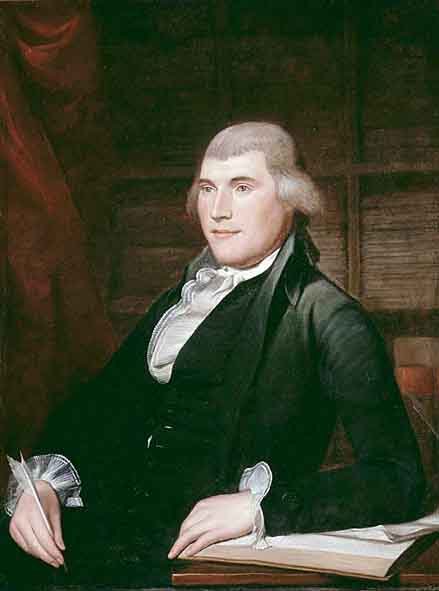
John Philip de Haas: 1772
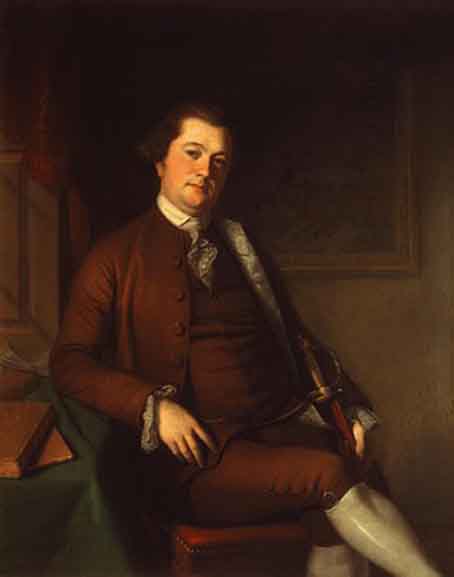
John Philip de Haas, soldier, born in Holland about 1735 and died in Philadelphia, 3 June 1786. His ancestors were an ancient family of northern France. In 1750 he removed with his father to the United States, settling in Lancaster County, Pennsylvania He was ensign in the old French war, and took part in Bouquet's battle with the Indians at Bushy Run, near Pittsburgh, 5 and 6 August 1763. In 1776 he was appointed colonel of the 1st Pennsylvania regiment. He served in Canada and at Ticonderoga, and after the battle of Long Island was promoted to brigadier general, 21 February 1777, serving until the close of the war. In 1779 he went to Philadelphia, where he spent the latter years of his life. His son served as ensign in his own regiment.
Governor Thomas McKean and his Son, Thomas, Jr: 1787

Thomas McKean was an American lawyer and politician from New Castle, in New Castle County, Delaware, and Philadelphia, Pennsylvania. During the American Revolution he was a delegate to the Continental Congress where he signed the United States Declaration of Independence and served as a President of Congress. He was at various times a member of the Federalist and Democratic-Republican parties, who served as President of Delaware, Chief Justice of Pennsylvania, and Governor of Pennsylvania.
Thomas McKean: After 1787
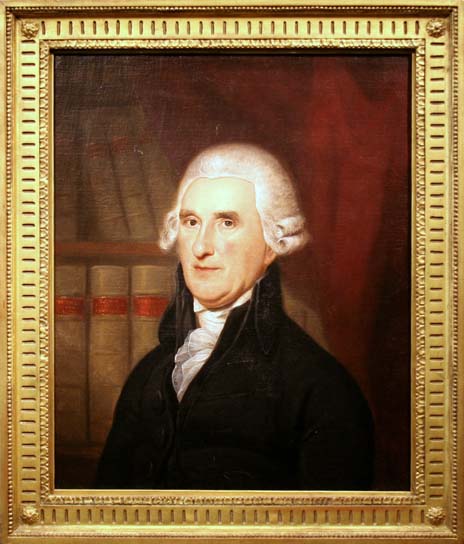
John Witherspoon: 1794
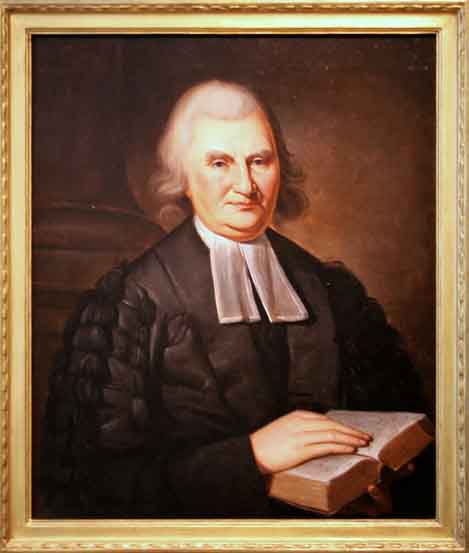
John Witherspoon was a signatory of the United States Declaration of Independence as a representative of New Jersey. He was both the only active clergyman and college president to sign the Declaration.
He suffered eye injuries and was blind by 1792. He died in 1794 on his farm Tusculum, just outside of Princeton, and is buried in the Princeton Cemetery. He was 71 when he died.
Jonathan Edwards
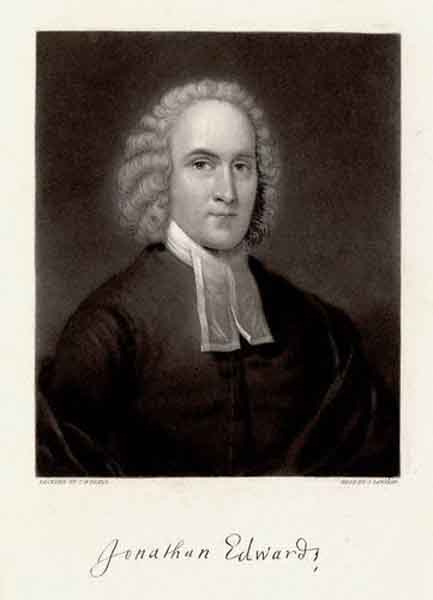
Jonathan Edwards was a colonial American Congregational preacher, theologian, and missionary to Native Americans. Edwards "is widely acknowledged to be America's most important and original philosophical theologian," and one of America's greatest intellectuals. Edwards' theological work is very broad in scope, but he is often associated with his defense of Reformed theology, the metaphysics of theological determinism, and the Puritan heritage. Edwards played a critical role in shaping the First Great Awakening, and oversaw some of the first fires of revival in 1733-1735 at his church in Northampton, Massachusetts. Edwards' sermon "Sinners in the Hands of an Angry God," is considered a classic of early American literature, which he delivered during another wave of revival in 1741, following George Whitefield's tour of the Thirteen Colonies. Edwards is widely known for his many books: The End For Which God Created the World; The Life of David Brainerd, which served to inspire thousands of missionaries throughout the nineteenth century; and Religious Affections, which many Reformed Evangelicals read even today. Edwards died from a smallpox inoculation shortly after beginning the presidency at the College of New Jersey (later to be named Princeton University), and was the grandfather of Aaron Burr.
Joseph Brant: 1797
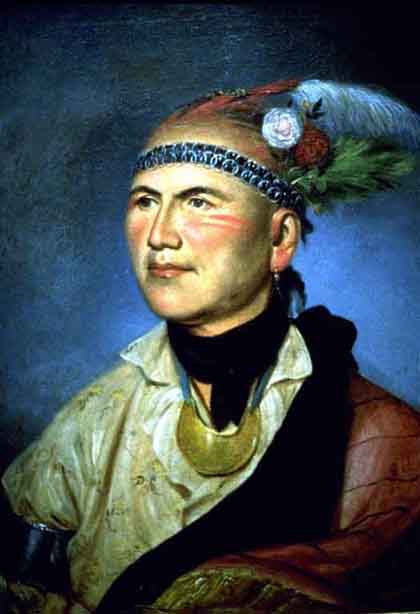
Joseph Brant: 1797
(Detail)
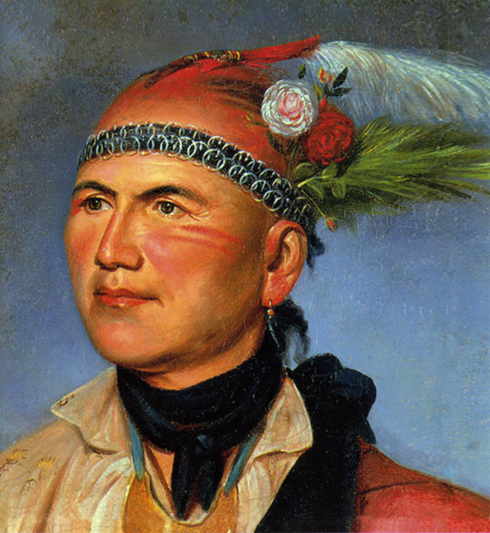
(1742-1807), British Army Officer and Mohawk Leader
Thayendanegea or Joseph Brant was the son of a Mohawk chief and a woman of mixed English and Indian descent. After his father's death, Brant lived with his sister's husband, William Johnson, superintendent of Indian Affairs North of the Ohio River from 1755 to 1774. This experience, combined with attendance at a Christian school in Connecticut, prepared him for work as a bicultural mediator between the English and Iroquois in the years leading up to the American Revolution.
When the Revolutionary War broke out, Brant traveled to England, and was commissioned Captain, and expressed his allegiance to the British crown. He returned to the Hudson River Valley and rallied the Iroquois to the Loyalist Cause, leading highly effective expeditions against Americans living in the region. These brought harsh retaliation from American forces under General John Sullivan in 1779. Brant continued to resist even after British troops ceased hostilities. The English rewarded him and a number of Mohawks for their services with a tract of land in Ontario, where Brant eventually died. Brant's leadership and skills as a mediator enabled him and his followers to carve out a degree of autonomy while facing Anglo?American expansionist pressures.
Joseph Brant died in his house at the head of Lake Ontario (site of what would become the city of Burlington, Ontario) on November 24, 1807. His last words, spoken to his adopted nephew John Norton, reflect his lifelong commitment to his people: "Have pity on the poor Indians. If you have any influence with the great, endeavor to use it for their good."
In 1850, his remains were carried 34 miles in relays on the shoulders of young men of Grand River to a tomb at Her Majesty's Chapel of the Mohawks in Brantford.
Landscape Looking Towards Sellers Hall from Mill Bank: 1818
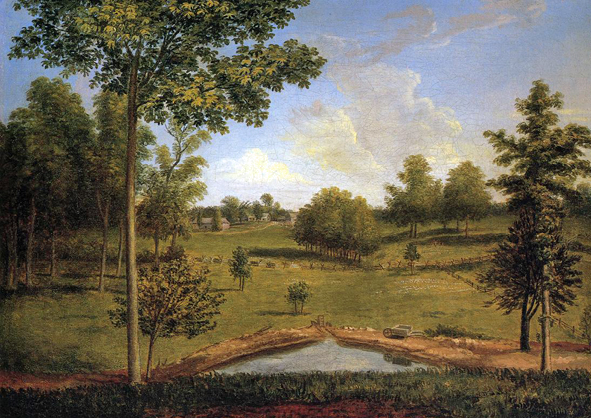
'Landscape Looking Toward Sellers Hall from Mill Bank' dates from approximately 1818, after Charles Willson Peale had moved from Philadelphia to nearby Belfield, where he conducted landscape experiments in both painting and horticulture. Peale's landscapes reveal his interest and participation in the nascent genre of American landscape painting that would lead to the Hudson River School of painting in the early 1820's. Peale stated his interest in landscape as "views that will look well in painting" and put that philosophy to use in this delightful composition of the gently rolling Pennsylvania countryside accented by trees, a pond, split-rail fences and a cluster of buildings in the distance.
Mill Bank: 1818
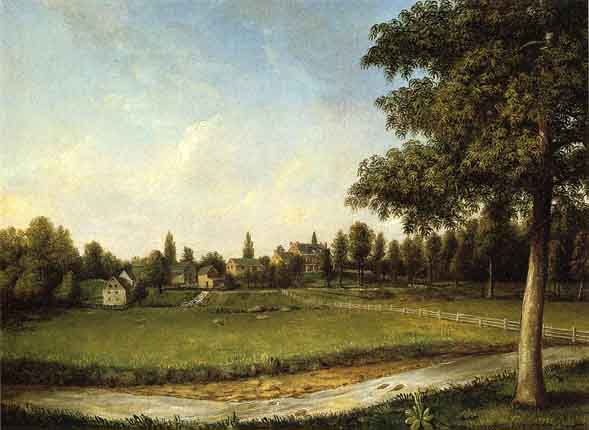
Le Duc de Liancourt: 1794-97
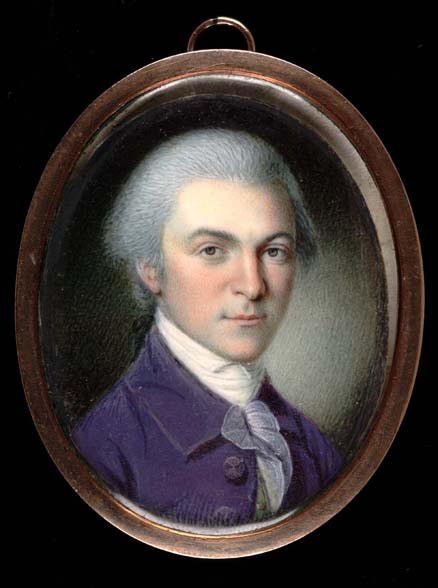
A staunch advocate of the French Revolution, Liancourt (1747-1827) was considered the French equivalent to Benjamin Franklin. He was part of Lafayette's entourage, and became friends with George Washington, as both men were farmers interested in new agricultural techniques. Nancy Shippen, a prominent Philadelphian, recorded his remark on American democracy: "In the days of my power, under the ancient regime of France, I had fifty servants to wait upon me, but yet my coat was never as well brushed as now that I do it myself." Liancourt wrote a two-volume book titled Travels through the United States of North America, the Country of the Iroquois and Upper Canada in the years 1795, 1796, and 1797, in which he recorded his experiences. His published memoirs made him one of France's most respected authors.
Lesueur Charles Alexandre: 1818
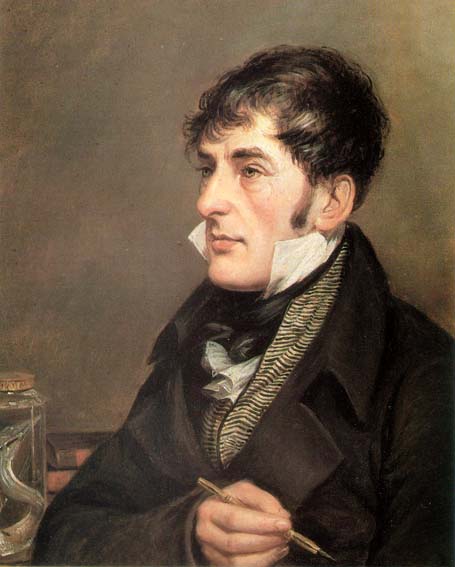
Charles Alexandre Lesueur was a French naturalist, artist and explorer. Lesueur was born in Le Havre.
In 1801 he traveled to Australia as artist on the expedition of Nicolas Baudin. With Francois Peron he took over the duties as naturalist after the death of the expedition's zoologist Rene Mauge. Together they collected over 100,000 zoological specimens. Between 1815 and 1837 he lived in the United States. In 1833, he visited Vincennes, Indiana where he sketched the first known drawing of Grouseland, the mansion of William Henry Harrison. The mansion is today a National Historic Landmark. In the years 1825-1837 Lesueur lived in Indiana.
Pictured here is the oil portrait by Charles Willson Peale of Charles-Alexandre Lesueur. The original hangs in the reading room of the of Ewell Sale Stewart Library in the Academy of Natural Sciences of Philadelphia.
In 1845 he was appointed curator of the Musee d'Histoire Naturelle du Havre.
Louis Lebegue Duportail: ca 1781-84
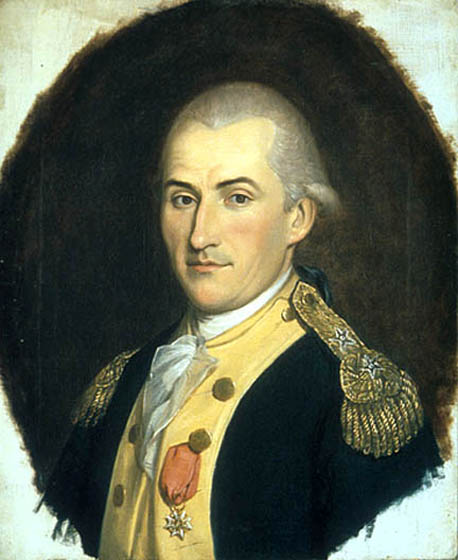
Louis Lebeque Duportail was a French military leader who served as a volunteer and the Chief Engineer in the Continental Army during the American Revolutionary War. He also served as the French Minister of Defense during the beginning of the French Revolution.
Duportail was born near Orleans, France, in 1743. He graduated from the royal engineer school in Mezieres, France, as a qualified engineer officer in 1765. Promoted to Lieutenant Colonel in the Royal Corps of Engineers, Duportail was secretly sent to America in March 1777 to serve in Washington's Continental Army under an agreement between Benjamin Franklin and the government of King Louis XVI of France. He was appointed Colonel and Commander of all Engineers in the Continental Army, July 1777; Brigadier General, November 17, 1777; commander, Corps of Engineers, May 1779; and Major General (Brevet), November 16, 1781.
Duportail participated in fortifications planning from Boston, Massachusetts to Charleston, South Carolina and helped Washington evolve the primarily defensive military strategy that wore down the British Army. He also directed the construction of siege works at the Battle of Yorktown, site of the decisive American victory of the Revolutionary War.
Returning to France in October 1783, Duportail became an infantry officer and in 1788 a Field Marshal. He served as France's minister of war from November 16, 1790, through December 7, 1791, during the beginning of the French Revolution and promoted military reforms. Forced into hiding by Radical Jacobins, he escaped to America and bought a farm near Valley Forge, Pennsylvania. He lived there until 1802, when he died at sea while attempting to return to France.
Margaret Strachan (Mrs Thomas Harwood): 1771
_1771.jpg)
Meriwether Lewis: 1807
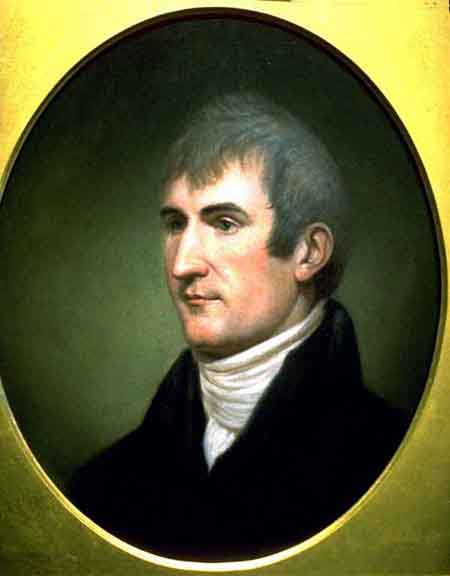
Meriwether Lewis was an American explorer, soldier, and public administrator, best known for his role as the leader of the Lewis and Clark Expedition also known as the Corps of Discovery, with William Clark, whose mission was to explore the territory of the Louisiana Purchase.
William Clark
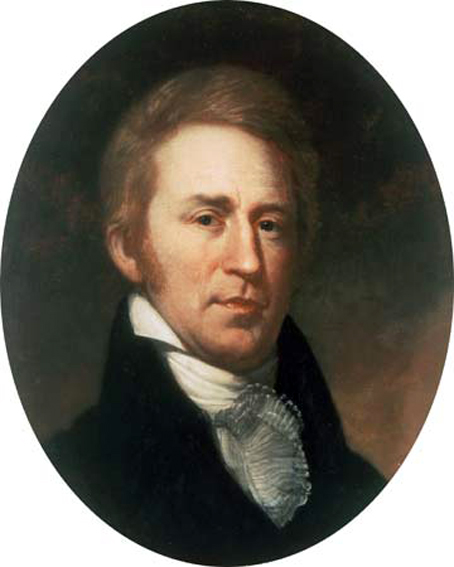
William Clark was an American explorer, soldier, Indian agent, and territorial governor. A native of Virginia, he would also grow up in pre-statehood Kentucky before later settling in what later became the state of Missouri. Along with Meriwether Lewis, Clark led the Lewis and Clark Expedition of 1803 to 1805 across the Louisiana Purchase to the Pacific Ocean. Before the expedition he served in a militia and the United States Army, while afterwards he served in a militia and as Governor of the Missouri Territory. From 1822 until his death he held the position of Superintendent of Indian Affairs.
The Louisiana Purchase

Lewis and Clark Expedition
Mrs Thomas Leiper and her Daughter
(Helen Hamilton Leiper): 1794

Mrs Walter Stewart: 1782
(Deborah McClenachan) (1763-1823)
_(1763_1823)_1782.jpg)
When Colonel Walter Stewart married eighteen-year-old Deborah McClenachan, he marked the occasion by commissioning this full-scale portrait of her, as well as portrait miniatures of the two of them, so that each might carry the image of the other. Peale shows the new bride wearing miniatures set in pearl bracelets; the one on her left wrist is probably a picture of her father, the one on her right, her new husband. With her arms delicately crossed, it is the latter's portrait that overshadows the former's, suggesting the new allegiance of a woman upon marriage. The Stewarts exemplified America's new aristocracy and were friends of George and Martha Washington. Peale, a leading colonial portraitist, evokes Deborah Stewart's social station through the fine miniatures, clothing, and interior, while the sheets of music and the instrument indicate her cultured upbringing.
Nancy Hallam as Fidele in Shakespeare's Cymbeline: 1771
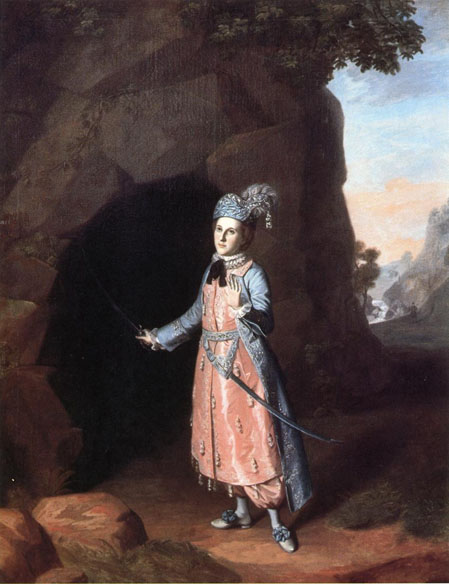
In 1771, Charles Willson Peale painted this portrait of actress Nancy Hallam, dressed in her costume as the boy Fidele in Shakespeare's Cymbeline. Hallam was a cousin of Lewis Hallam the younger, who in 1752 had brought the first theater company from England to the colonies. Based in New York, Hallam's company also performed in Philadelphia in the 1750's and 1760's.
Nathanael Greene: 1783
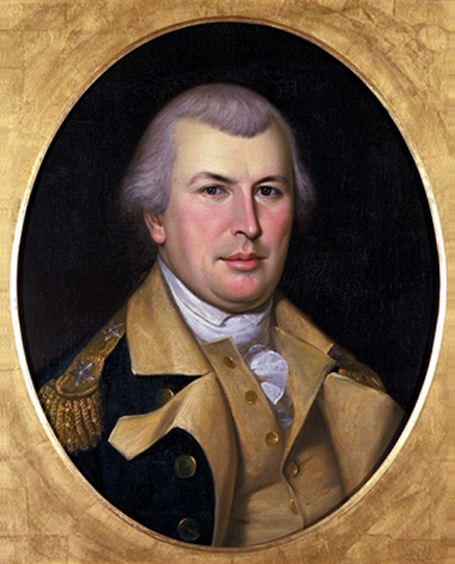
Nathanael Greene was a Major General of the Continental Army in the American Revolutionary War. When the war began, Greene was a militia private, the lowest rank possible; he emerged from the war with a reputation as George Washington's most gifted and dependable officer.
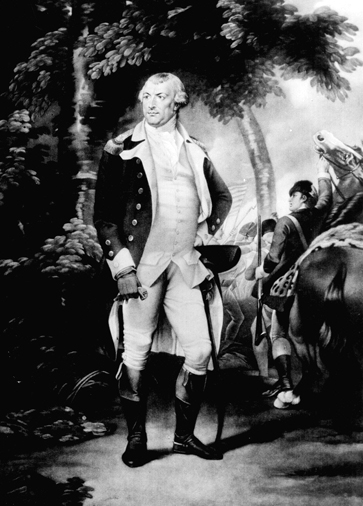
Nathaniel Gorham: ca 1793
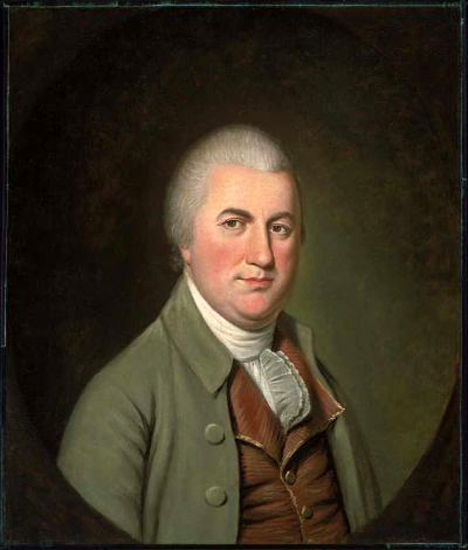
Nathaniel Gorham was born in Charlestown, Massachusetts on May 27th, 1738 and died there on June 11th, 1796. He was the son of a small boat operator growing-up in a family of modest means. After receiving a public school education, Gorham worked in various small businesses in his birthplace of Charlestown. He was apprenticed in 1754 to Nathaniel Coffin, a merchant in New London, Connecticut where he learned the import and export business. He left Coffin's employ in 1759 and returned to his hometown establishing his own small business there, which quickly succeeded.
In 1763 he wed Rebecca Call, who was to bear the couple nine children. In 1770, Gorham launched his public career as a notary, soon winning election to the colonial legislature in 1771. He took an active part in public affairs at the beginning of the Revolution, as a strong supporter of the Whigs. He was then elected delegate to the Massachusetts' Provincial Congress in 1774 and served throughout 1775. During the war he was a member of the Massachusetts board of war from 1778 until its dissolution in 1781, which oversaw the State's military strategy, logistics and recruitment. He paid the price for the effective service in that office, as British troops ravaged much of his property during the occupation of Charlestown.
In 1779 he served in the State constitutional convention. He was a delegate to the Continental Congress from 1782 until 1783, and also from 1785 until 1787. Gorham also served a term as judge of the Middlesex County, Massachusetts Court of Common Pleas.
For several months in 1787, Gorham served as one of the Massachusetts delegates to the United States Constitutional Convention. Gorham frequently served as Chairman of the Convention's Committee of the Whole, meaning that he (rather than the President of the Convention, George Washington) presided over convention sessions during the delegates' first deliberations on the structure of the new government in late May and June of 1787. After the convention, he worked hard to see that the Constitution was approved in his home state.
Noah and His Ark: 1819
_1819.jpg)
Otho Holland Williams (1749-94)
.jpg)
Otho Holland Williams was a Continental Army officer from Maryland in the American Revolutionary War. He entered service volunteering at a Lieutenant in 1775 and eventually rising to the rank of Brigadier General. He later served as an Associate Justice for Baltimore County, and as the first Commissioner of the Port of Baltimore.
Portrait of a Gentleman: 1775
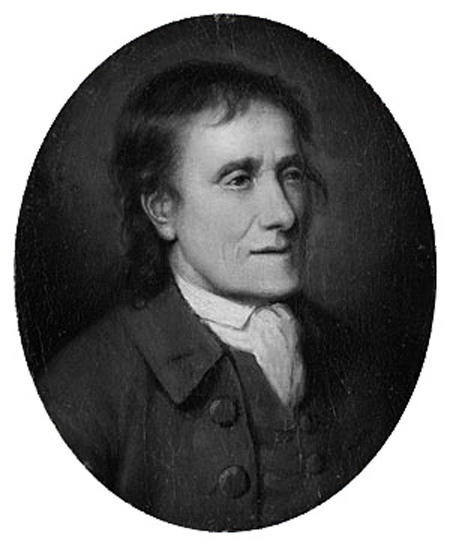
Portrait of a Woman: 1775
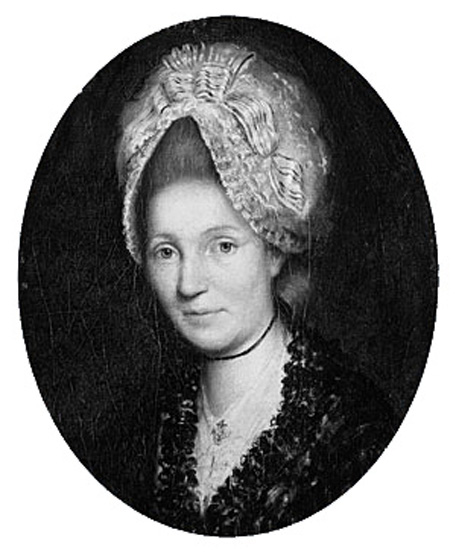
Portrait of Colonel John Cox: 1792-93
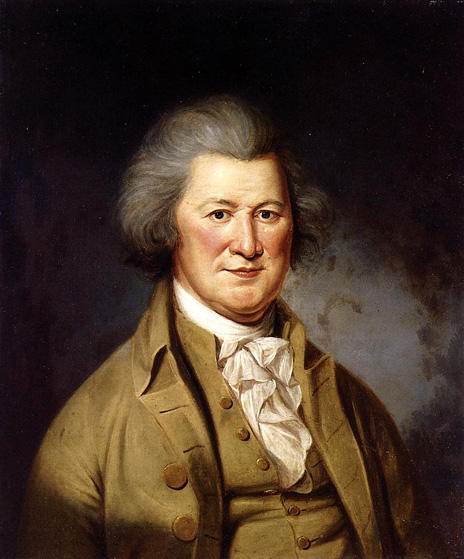
Portrait of Edmund Physick: 1795
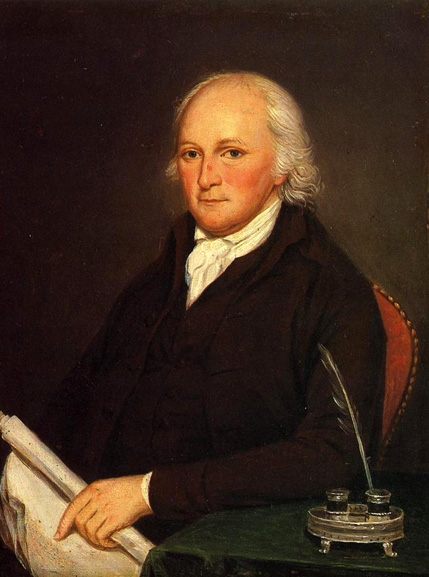
Portrait of James W DePeyster: 1798

James W. DePeyster was the uncle of Charles Willson Peale's second wife, Elizabeth DePeyster. While Peale was staying at the DePeyster's home in 1798, he painted the present portrait of James, a companion portrait of his wife Anna and miniatures of each. Peale later wrote in his diary in June of that year: "I have painted the Portraits of Mr. James W. DePeyster and Lady in oil, also their portraits in miniature. I finished all of these portraits to the entire satisfaction of the family-"
Anna DePeyster
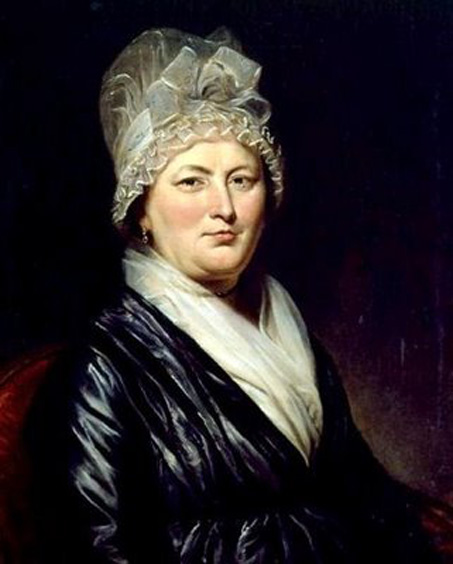
Portrait of Mr Francis Bailey
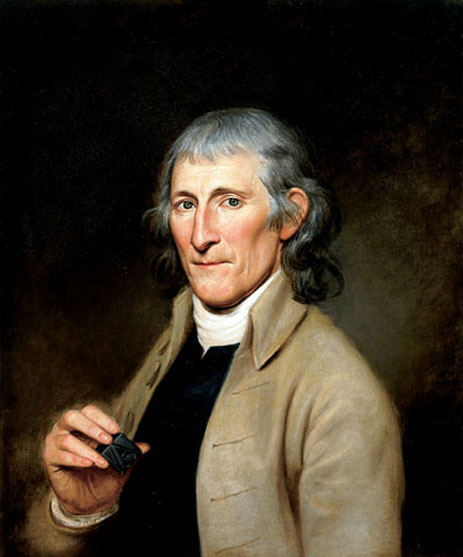
The subject of this painting, Francis Bailey, was a friend and neighbor of Benjamin Franklin, and was a prominent journalist and the official printer for Congress and the state of Pennsylvania. He is depicted holding a piece of printer's type.
Mrs Francis Bailey: 1791
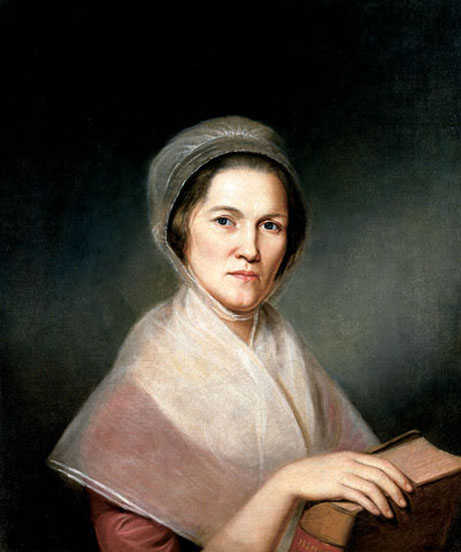
Portrait of William Harris Crawford: 1818
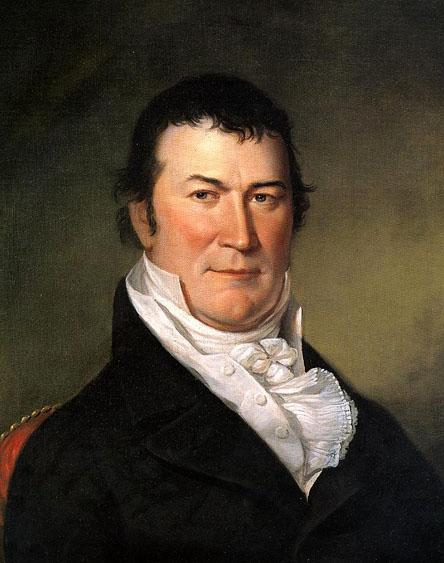
A prominent citizen of Lexington, Georgia, William Harris Crawford sat for this portrait while he was Secretary of the Treasury under President James Madison. Peale had intended to display the painting in a national portrait gallery in Washington, but Congress failed to fund the project.
Reverend Joseph Pilmore: 1787
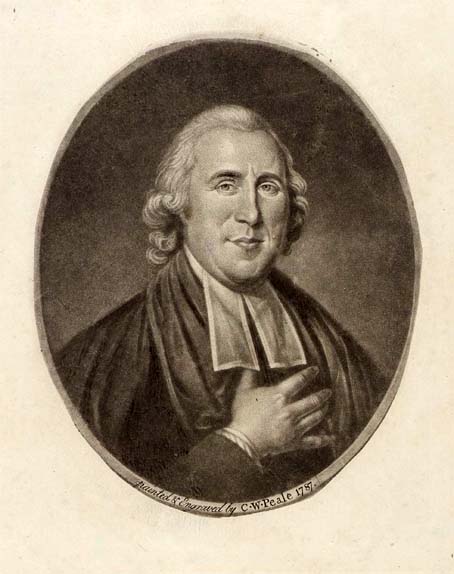
Joseph Pilmore, clergyman, born in Tadmouth, Yorkshire, England, 31 October, 1739; died in Philadelphia, Pennsylvania, 24 July, 1825. He obtained his education in John Wesley's school at Kingswood, and undertook the work of an itinerant or lay preacher under Wesley's direction. In 1769 he came to this country on a mission to establish Methodism in Philadelphia. He preached from the steps of the state-house on Chestnut Street, from stands in race-fields, and rode the circuits with his library in his saddle-bags, holding the first Methodist meeting in Philadelphia in a pot-house in Loxley's court, and establishing the first church that was owned by the Methodists in Philadelphia. It is the present church of Saint George, and was an unfinished building purchased from the Germans, which the British seized, when they were in possession of the city, and used as a cavalry riding-school. After the American Revolution, Mr. Pilmore applied for orders in the Episcopal Church. He was ordained deacon, 27 November, 1785, by Bishop Seabury, and priest two days later, by the same bishop, and became rector of three united parishes in the vicinity of Philadelphia. From 1789 till 1794 he served as assistant to Reverend Dr. Samuel Magaw. He was then called to Christ Church, New York city, where he remained ten years. In 1804 he succeeded Dr. Magaw as the Rector of St. Paul's church, Philadelphia. He received the degree of D. D. from the University of Pennsylvania in 1807. Dr. Pilmore bequeathed half his fortune to the Episcopal Church, and half to the Society of Saint George, an organization for the aid of English emigrants. He published "Narrative of Labors in South Wales" (Philadelphia, 1825), and left in manuscript an account of his "Travels and Trials and Preaching" in various American colonies.
Richard Henry Lee: ca 1795-1805
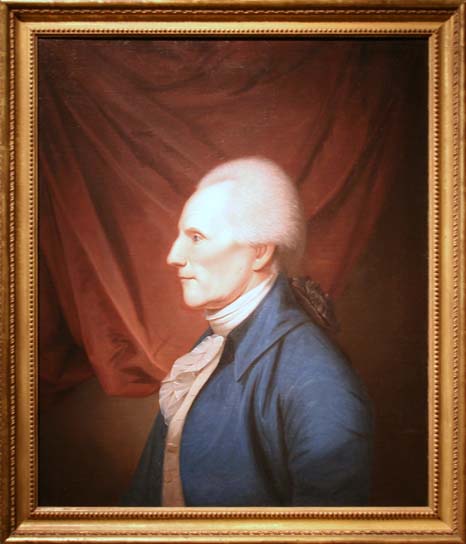
Richard Henry Lee was an American statesman from Virginia best known for the motion in the Second Continental Congress calling for the colonies' independence from Great Britain. His famous resolution of June 1776 led to the United States Declaration of Independence, which Lee signed. He also served a one-year term as the President of the Continental Congress, and was a U.S. Senator from Virginia from 1789 to 1792, serving during part of that time as one of the first Presidents pro tempore.
In August 1774, Lee was chosen as a delegate to the First Continental Congress in Philadelphia. In Lee's Resolution on the 7th of June 1776 during the Second Continental Congress, Lee put forth the motion to the Continental Congress to declare Independence from Great Britain. which read:
Resolved: That these United Colonies are, and of right ought to be, free and independent States, that they are absolved from all allegiance to the British Crown, and that all political connection between them and the State of Great Britain is, and ought to be, totally dissolved.
That it is expedient forthwith to take the most effectual measures for forming foreign Alliances.
That a plan of confederation be prepared and transmitted to the respective Colonies for their consideration and approbation.
Robert Goldsborough and Family: 1789

Robert Goldsborough was an American lawyer and statesman from Maryland. He served as a delegate to the Continental Congress.
Robert was the son of Charles Goldsborough, and was born on the family estate (Horns Point) at Cambridge in Dorchester County, Maryland. His father owned over 10,000 acres of land, and became a member of the Governor's Council in 1760. As a young man Robert travelled to London to study law at the Inner Temple, where he was admitted to the bar in 1754. He remained there practicing law as a Barrister until 1759 when he returned to America. He attended the Philadelphia College (now the University of Pennsylvania), and graduated in 1760 before resuming the practice of law in Cambridge, Maryland.
Goldsborough was the sheriff of Dorchester County from 1761 to 1765. He began his service in the Maryland Assembly in 1765, and served as the colony's Attorney General in 1766. He became active in the protests that led to the American Revolution, joining Maryland's "Committee of Safety". In 1774 he was sent as a delegate to the Continental Congress, where he served until May of 1776. Later that year he attended the Convention that drafted Maryland's first state constitution. Under the new state constitution, he was elected to the first Maryland Senate in 1777.
Robert narrowly missed two chances to be listed formally as one of the Founding Fathers of the United States. He withdrew from the Continental Congress six weeks before the Declaration of Independence to return home and work towards Maryland's first constitution. In 1787, he was selected as a representative to attend the U.S. Constitutional Convention, but didn't attend due to poor health. He died the following year at home at Horns Point, and is buried in the Christ Episcopal Church Cemetery in Cambridge, Maryland.
Robert Morris

After immigrating to Pennsylvania from England at the age of thirteen, Robert Morris went on to become the most famous financier of the American Revolution. In the 1790's Morris went bankrupt, then spent three and a half years in debtor's prison. He lived his final years in a small house in Philadelphia, according to friend, "a nearly forgotten and much pitied man."
Gouverneur Morris and Robert Morris
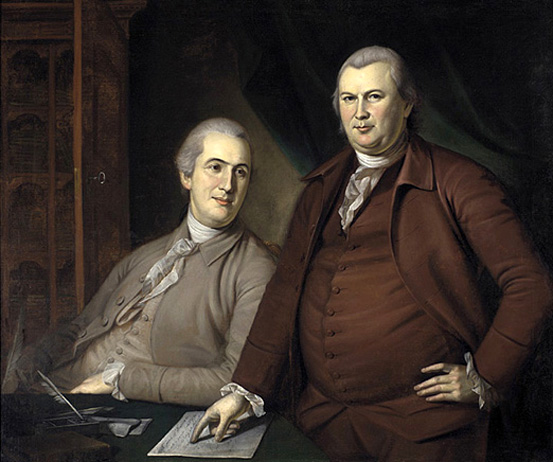
When Charles Willson Peale painted this dual portrait in 1783, Robert Morris, on the right, was the United States Minister of Finance. Gouverneur Morris, on the left, was then his assistant. A New York patriot who moved to Philadelphia during the war for independence, Gouverneur Morris would be a Pennsylvania representative to the 1787 Constitutional Convention, and one of the principal draftsmen of the Constitution.
Samuel Mifflin: 1777-80
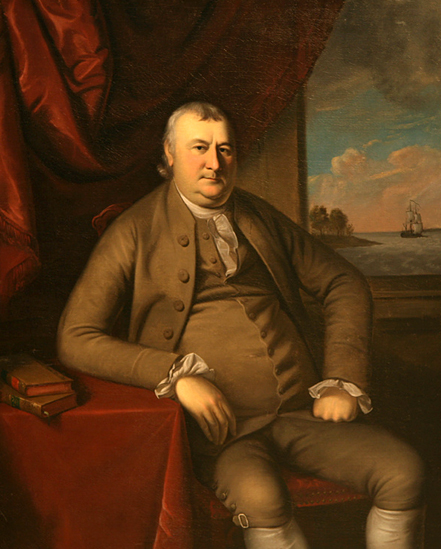
Mrs Samuel Mifflin and her Granddaughter Rebecca Mifflin Francis: 1777-80
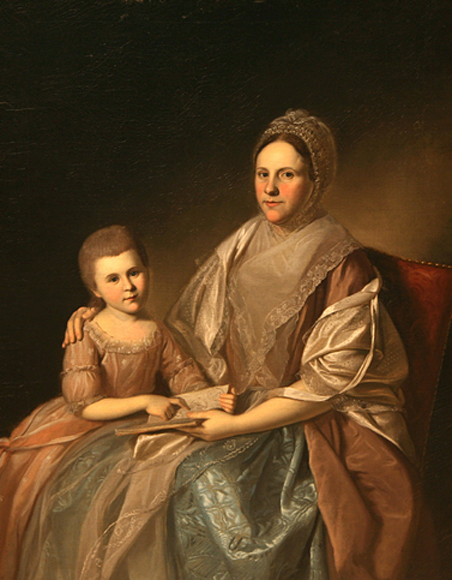
Self Portrait
(aka Study for The Artist in His Museum): 1822
_1822.jpg)
Self Portrait: ca 1795-1805
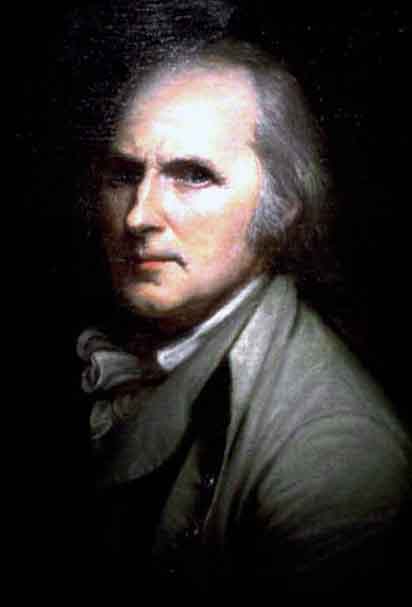
Washington, Lafayette, and Tilghman at Yorktown
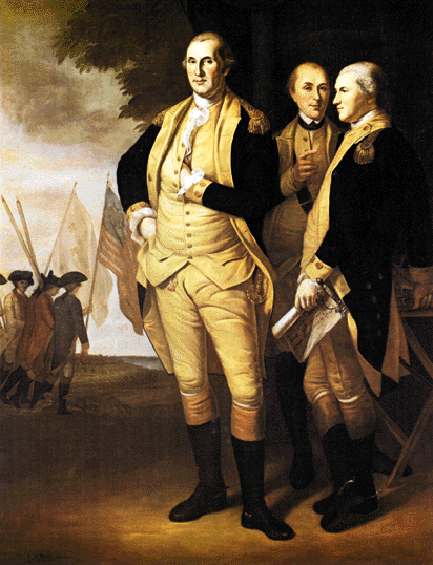
Charles Willson Peale's famous "Annapolis portrait" of Washington was commissioned by the Maryland legislature in November 1781, "in grateful remembrance of that most illustrious character." The figure of Washington, based on a sitting of 1783, is flanked by that of the Commander-in-Chief's military secretary and aide-de-camp, Lt. Col. Tench Tilghman, "representing the embattled State of Maryland." Lafayette, behind and between them, symbolizes the French Alliance.
The Artist's Mother, Mrs Charles Peale and Her Grandchildren: 1783
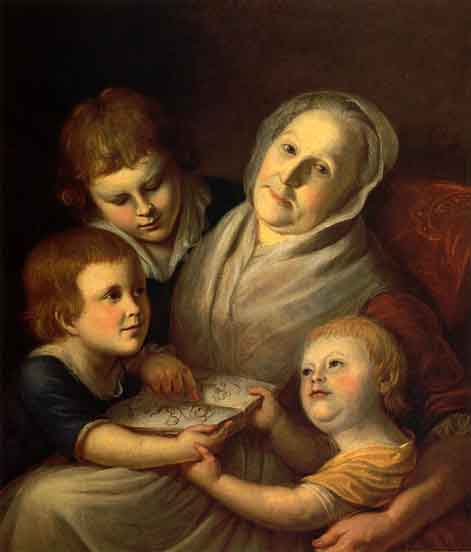
The Stewart Children (aka Isabella and John Stewart): 1773-74
_1773_74.jpg)
When Charles Willson Peale painted a portrait for fellow Annapolis resident Anthony Stewart, he tailored it to his patron in ways besides including likenesses of Stewart's son, John, and daughter, Isabella. Although the setting is not a cultivated part of a plantation like Mount Stewart-the elder Stewart's property on Maryland's Eastern Shore-the depiction of peaches on the ground near a body of water evokes that property and its bounty. The thistle at far right signifies the Scottish-born Stewart's ancestry, that plant being Scotland's national emblem. Yet of the aspects of the portrait fitted to its patron, the most remarkable is the way that its story invited him to contemplate an immoral orientation towards property acquisition. What are likely to have been Peale's beliefs about Stewart's character and deeds apparently inspired the painter to foster this experience, one with a foundation in a widely available, if rarely used idea about what portraits can do.
Peale planned this portrait to invoke the moment in sacred history just before Eve ate the forbidden fruit. That the Stewarts' fruit is a peach would not have misled an eighteenth-century viewer; Genesis and Milton both describe the fruit of the tree of the knowledge of good and evil without mentioning apples. Not only did this event mark the origin of mankind as fallen, but Milton's account of it fostered Peale's origin as a painter since he based his first oil painting on a related engraving from an illustrated edition of Paradise Lost.
The Fall humbles most everything John does. His working is a legacy of Adam, condemned to labor. His collecting food contrasts with how man and woman in Eden had no need to gather or store. Clothes, too, are badges of sin. John's cape, breeches, bows, lace collar, and cuffs derive from portraits by Antony Van Dyke, painter to England's royalty and aristocrats. Yet these fancy threads ill befit John's activity. Adam was to labor by the sweat of his brow, and John has already removed his hat. How many more trips can he make before he spoils the splendid garments that are to promote him as a young gentleman?
Peale structured 'The Stewart Children' to foster the idea that John thinks about the past; he and his sister are Adam and Eve's children as much as they are those first parents' analogues. Yet the painting also promotes the idea that he contemplates various moments in the future: he can see that Isabella will eat presently; ruining his clothes looms ahead; and he has the opportunity to think about whether he will develop a moral relationship to property. Although looking at the peach just slows him down at present, the perpetual present of the scene encourages considering this change of pace as a principle. His attention to the peach, which ultimately fosters recognizing the link between his acquisitiveness and sin, thus implies a future characterized by restraint.
Thomas and Henry Sergeant: ca 1787

Thomas Elliott and His Granddaughter Deborah Hibernia: ca 1796-97
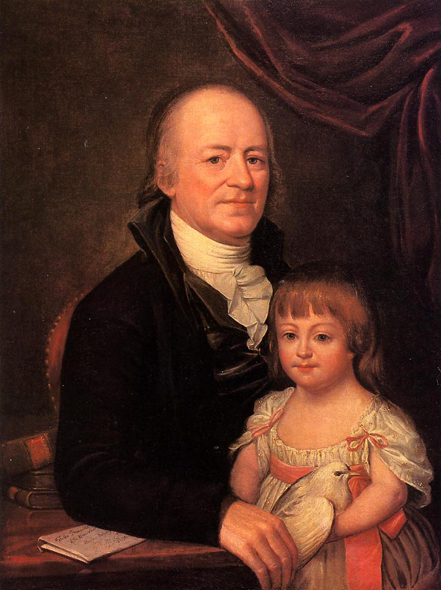
Thomas Willing: 1782

Timothy Matlack: ca 1790
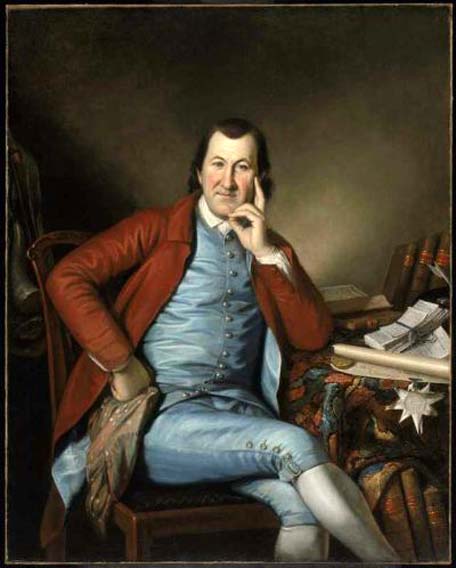
Peale's portrait of Timothy Matlack honors the sitter's distinguished public career. A radical Whig, Matlack played an active role in Revolutionary events in and around Philadelphia: he was the Transcriber who hand-lettered the original Declaration of Independence, he led a rifle battalion at Trenton and Princeton, and he was elected to the Continental Congress, among other things. The items with which he is shown reflect his role in forging the new nation and include the great seal of Pennsylvania and the constitution of that commonwealth, which he helped draft. Also included are law books, which attest to his political life, and a Bible, which may refer to his activity in founding the Society of Free Quakers, an alternative form of Quakerism whose followers had been expelled from the pacifist Religious Society of Friends for participating in the Revolutionary War.
Timothy Pickering
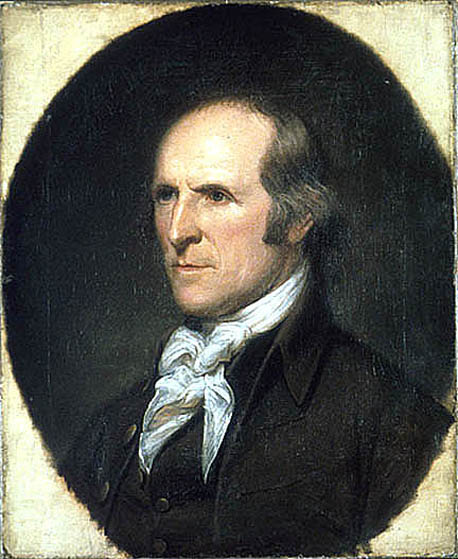
Timothy Pickering was a politician from Massachusetts who served in a variety of roles, most notably as the third United States Secretary of State, serving in that office from 1795 to 1800 under Presidents George Washington and John Adams.
View of the Garden at Belfield: 1816
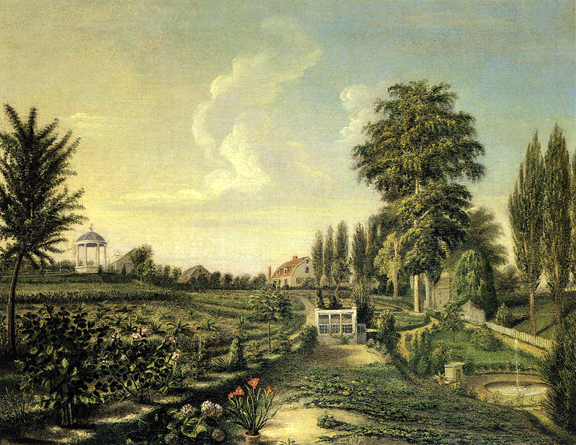
William Buckland (1734-1774)
_1774_and_1789.jpg)
Peale's portrait of Buckland, the Annapolis architect and builder, was begun when Buckland was in the flush of his success, having finished his architectural masterpiece, the Matthias Hammond House. Peale, who was himself advancing rapidly as Maryland's premier portrait painter, shows Buckland in a relaxed pose holding a drafting pen, with the architectural plans for Hammond House on the table. The constructed building is subtly drawn in the background. Peale has caught Buckland's vigorous personality and strength of character, creating a portrait of vivacity and individuality. Buckland died unexpectedly before the portrait was finished, and Peale did not complete it until fifteen years later, at the request of the sitter's daughter.
William Moultrie: 1782
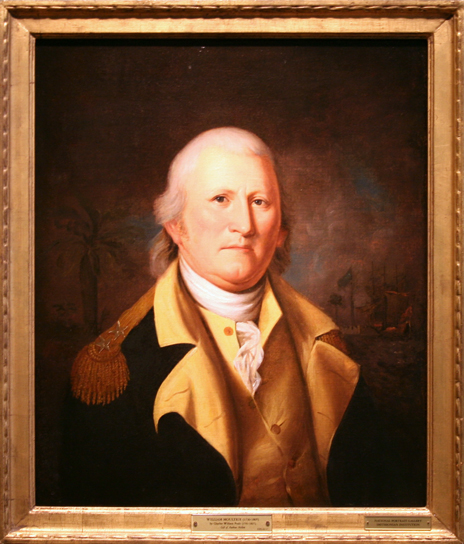
Until 1760 William Moultrie had a fairly undistinguished career as a member of South Carolina's provincial assembly. But after playing a central role in putting down a Cherokee Indian Uprising, he became a leader in his colony's military affairs, and early in the Revolution his expertise won him the command of the Continental Army's Second Regiment. In 1776 his successful defense of the Fort guarding Charleston harbor against a British fleet made him a national hero. Four years later the British captured him, and until 1782 he remained their prisoner.
In the original version of this portrait by Charles Willson Peale, a single star on the subject's epaulet indicates that Moultrie sat for it before Congress promoted him from brigadier to major general in late 1782. In this somewhat later replica, the artist updated his likeness by adding the second star. To commemorate the South Carolinian's finest moment in the field, Peale painted him against a rendering now barely perceptible, of the Charleston fortifications that he had so ably defended six years earlier.
William Paca (1740-1799): 1772
_1772.jpg)
William Paca was a signatory to the United States Declaration of Independence as a representative of Maryland.
William Paca was born in Abington, Maryland on October 30, 1740. His education in law was impressive. He was tutored at home in the classics before attending Philadelphia College at age fifteen, where he graduated at eighteen with a Masters degree. He then studied law in Annapolis at the office of an eminent lawyer.
Before seeking admission to the Bar of Maryland, he attended training at the Inner Temple in England. His political engagement began in his interest in the law. He wrote and organized against a poll-tax originated by the royal governor just prior to the outbreak of hostilities. He was a local leader in the patriot movement in the late 1770's.
Elected to the State Legislature of Maryland in 1771, he was appointed to the Continental Congress in 1774. He was reelected and served there until 1779 when he was appointed Chief Justice of the State of Maryland. In 1782 he was elected governor of that state. He was appointed federal district judge for the State of Maryland from 1789, until his death in 1799.

(William Paca Former Governor of Maryland and Signer of the Declaration of Independence)
William Smith and His Grandson: 1788

Elegant portraiture, sometimes with a landscape view in the background, was America's first important contribution to painting. Landscape for its own sake was a nineteenth-century phenomenon. A private family once treasured this image for the personal memories it aroused. Today the picture has a generic value, celebrating the bond between old and young.
Source: Art Renewal Center
Source: Charles Willson Peale Online
This page is the work of Senex Magister
Return to Pagina Artis
Return to Bruce and Bobbie's Main Page.
















_1795.jpg)









_1816.jpg)














_Rush_1776.jpg)








_1774_75.jpg)































_1771.jpg)




_(1763_1823)_1782.jpg)




_1819.jpg)
.jpg)
















_1822.jpg)



_1773_74.jpg)






_1774_and_1789.jpg)

_1772.jpg)

